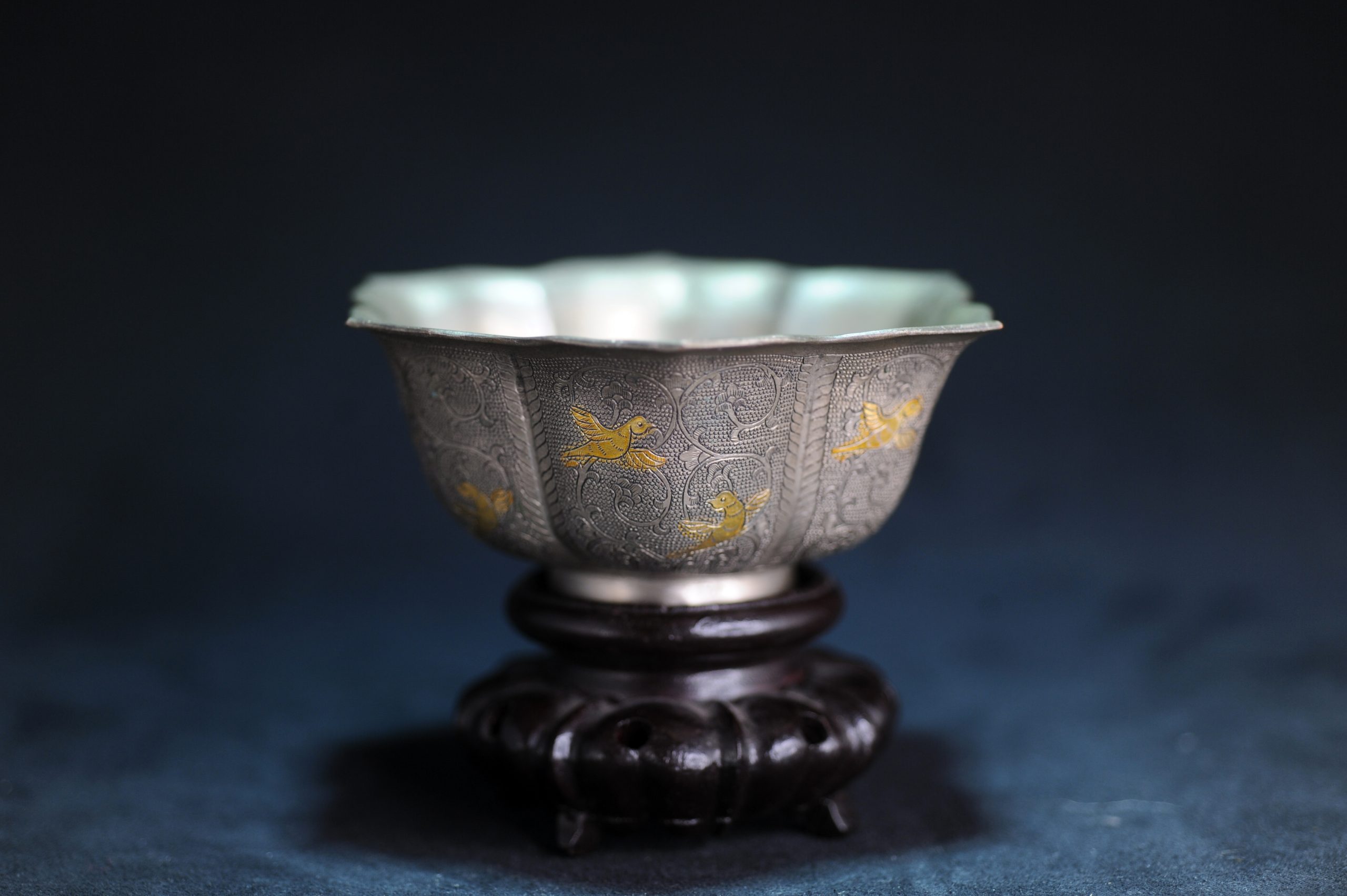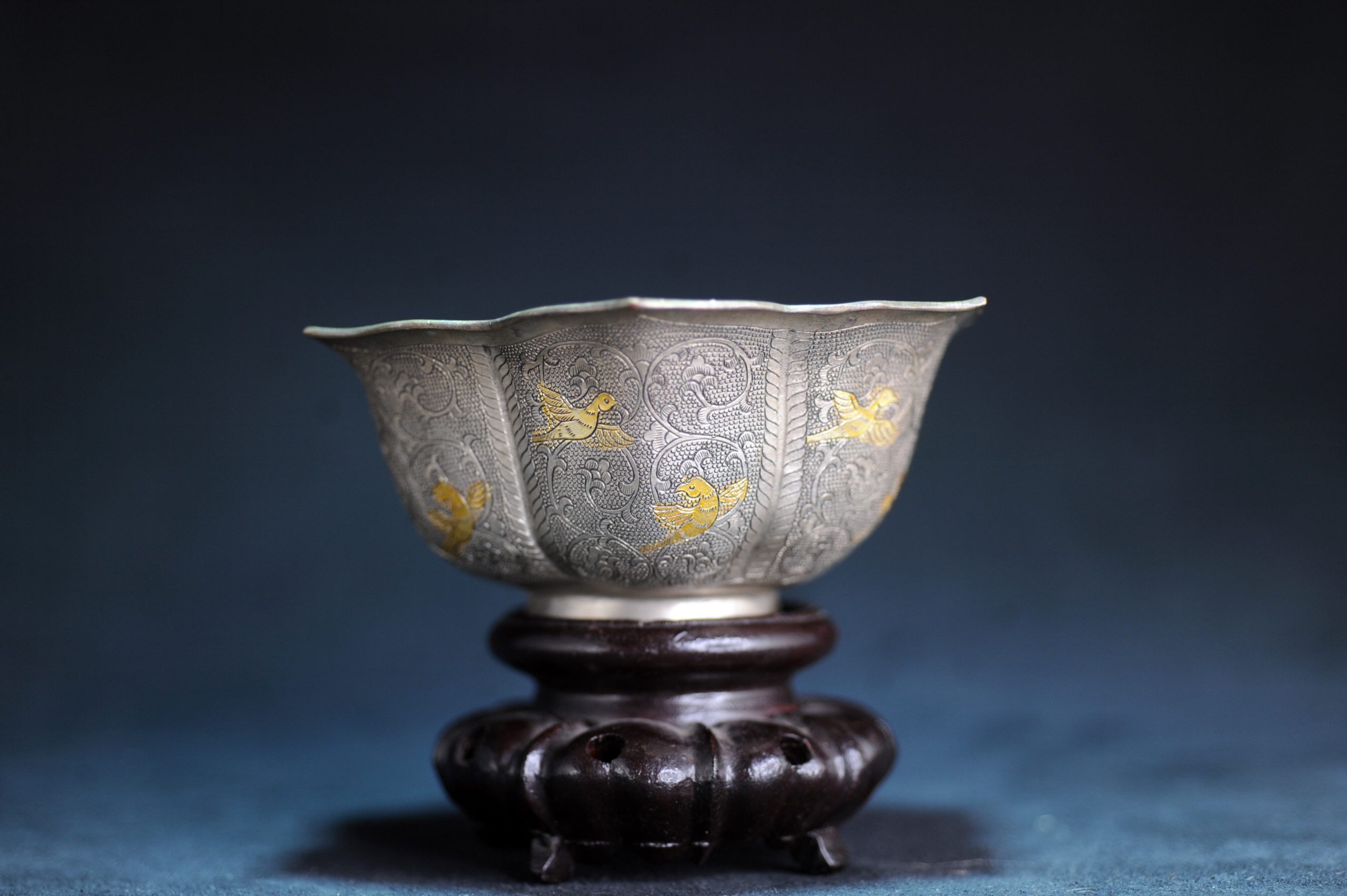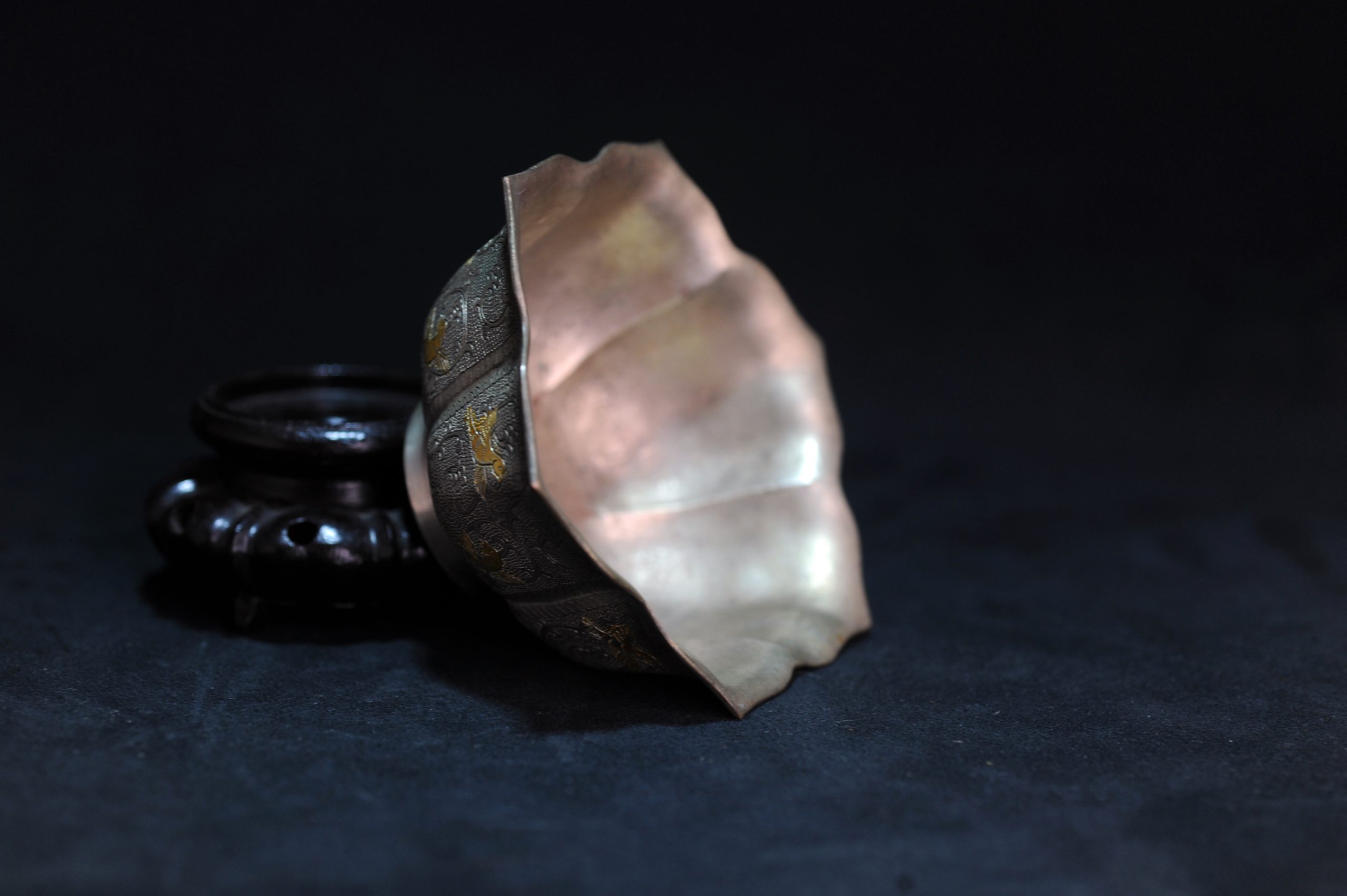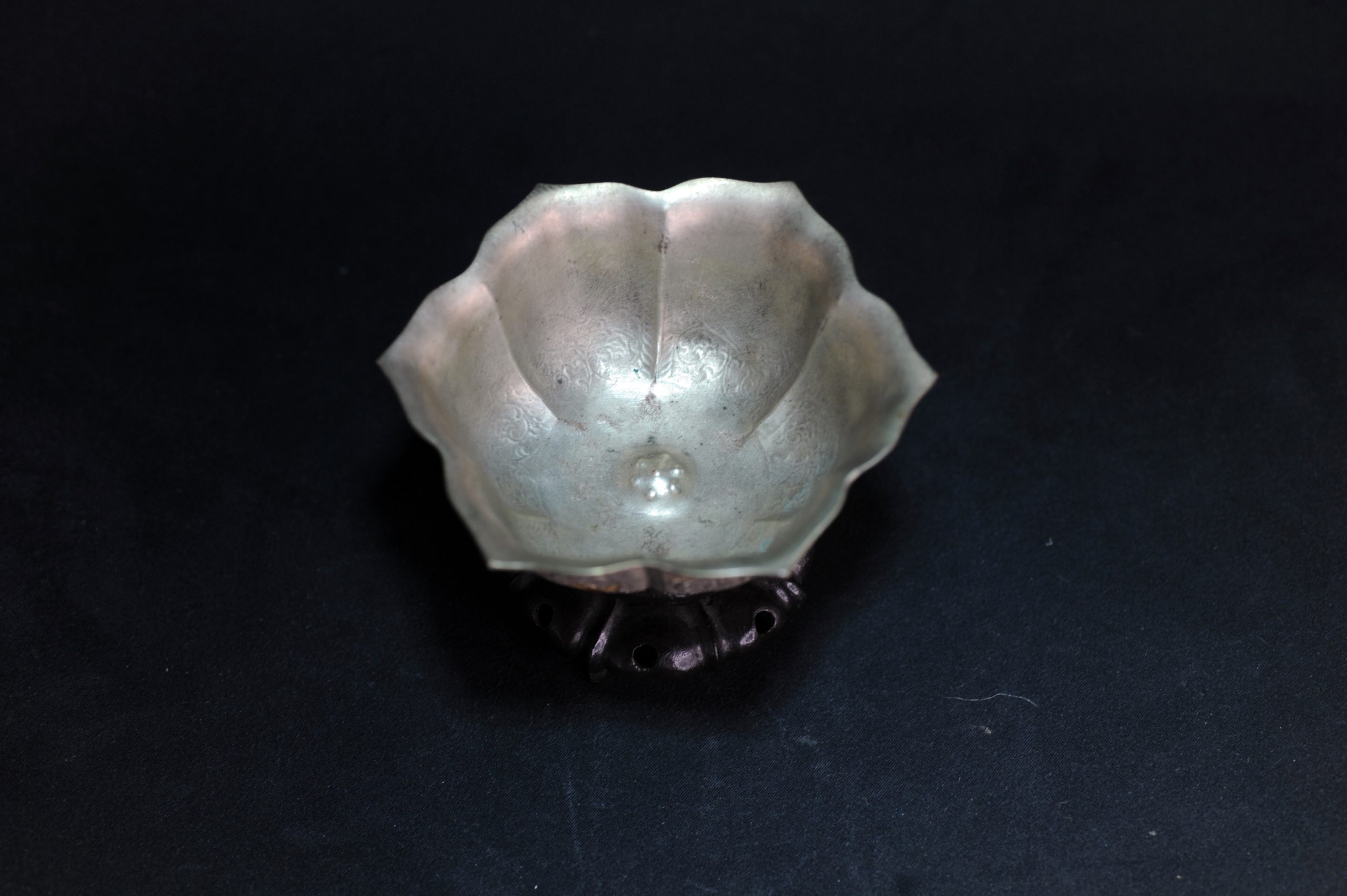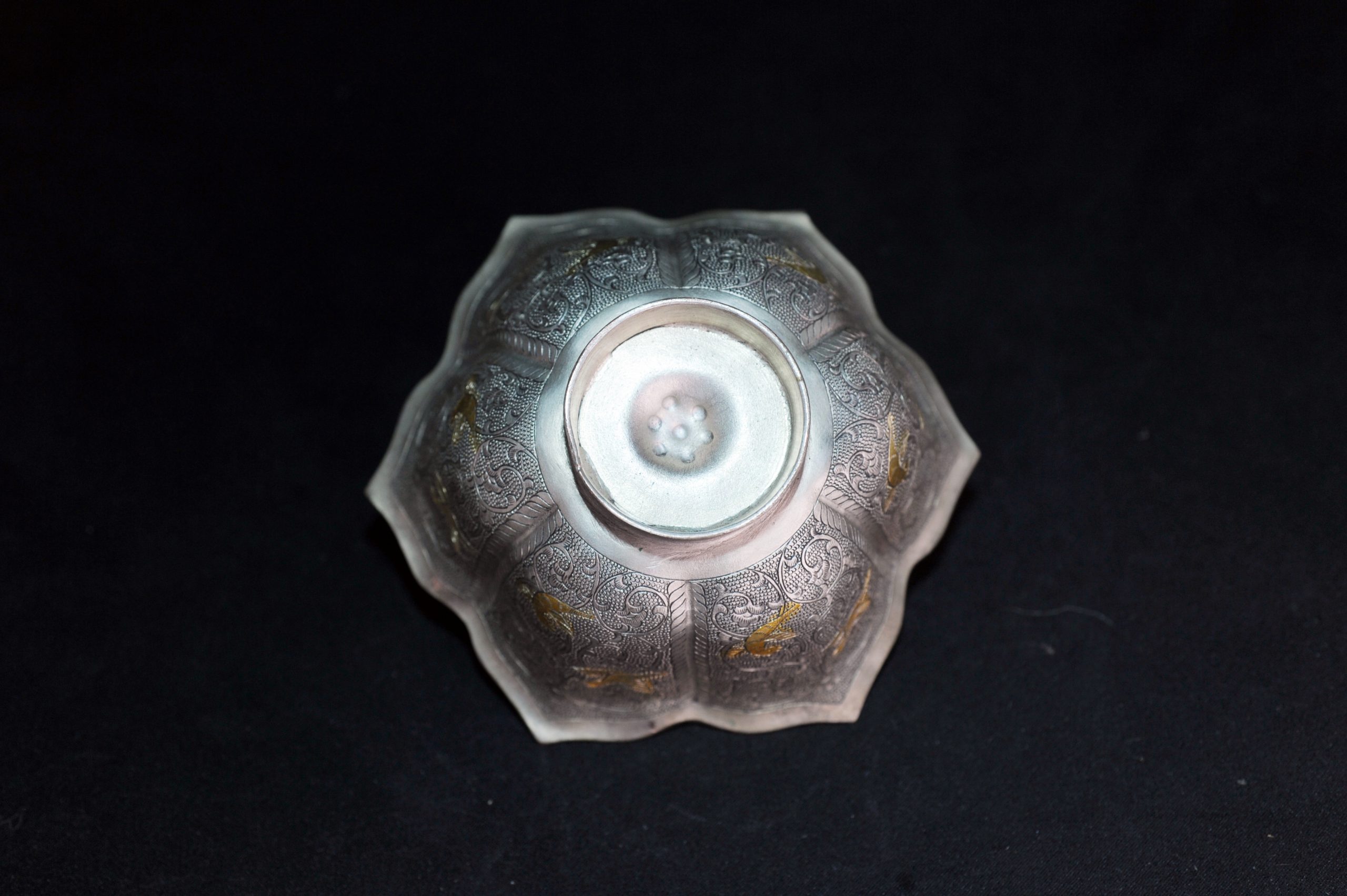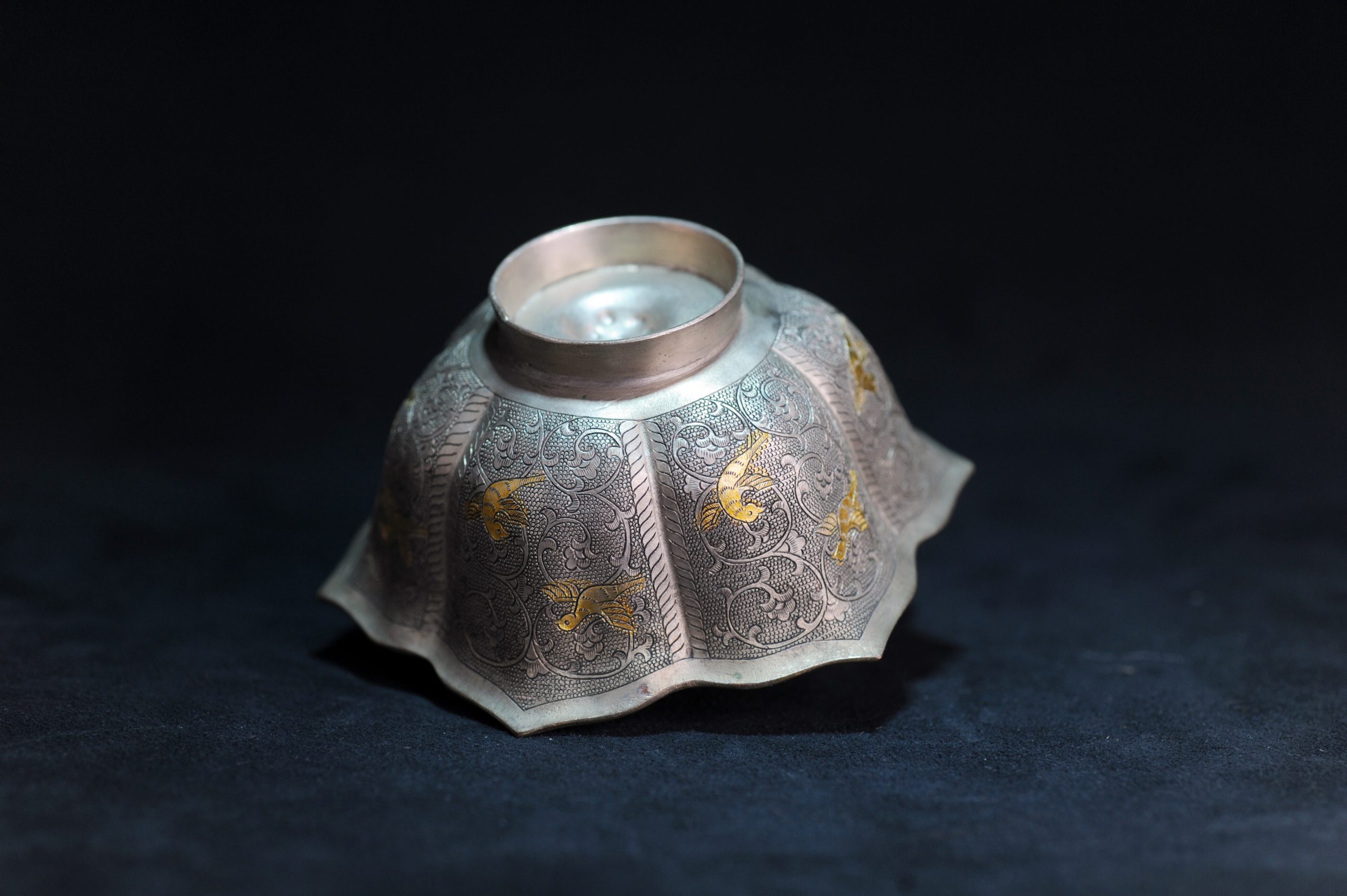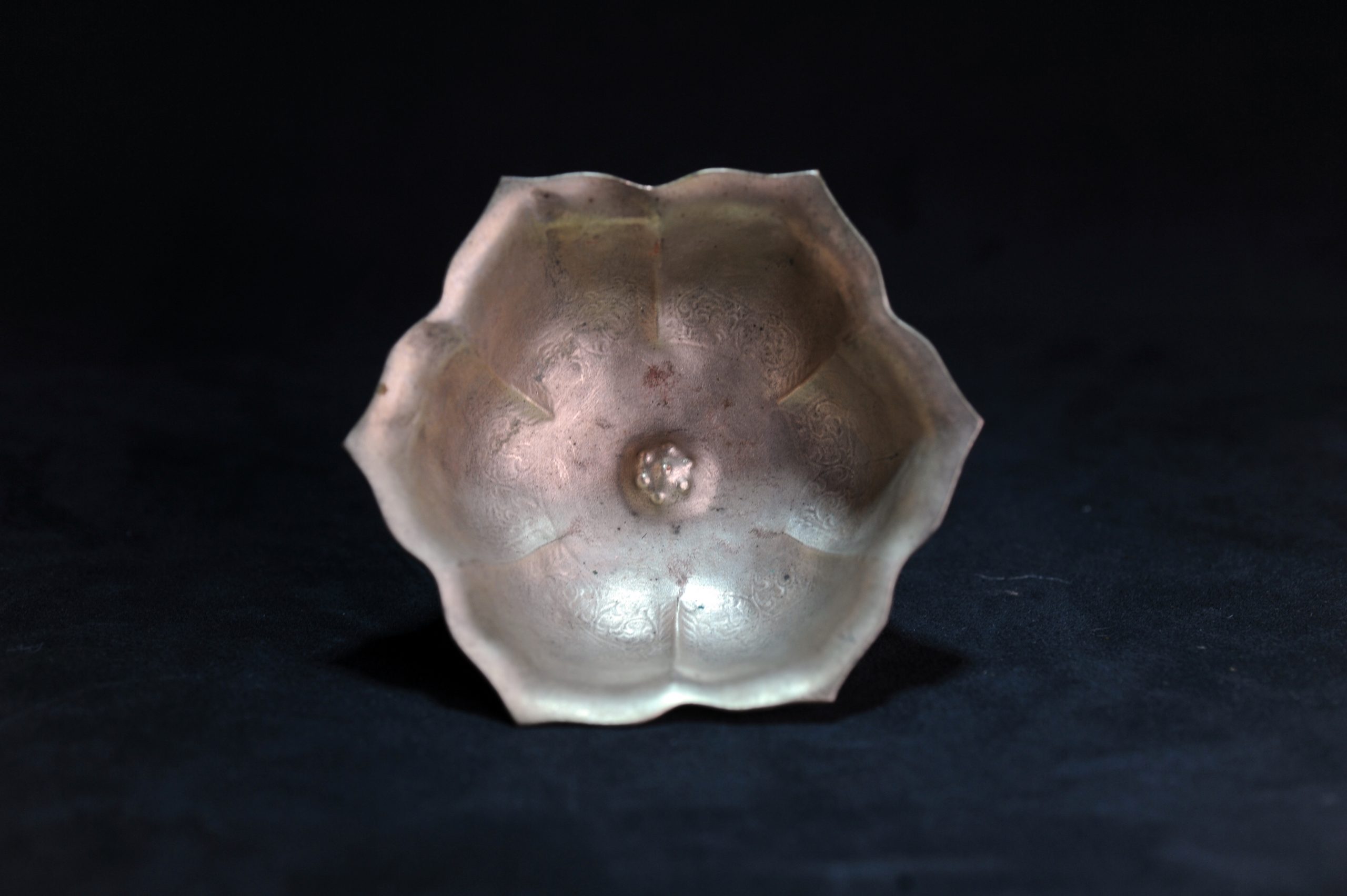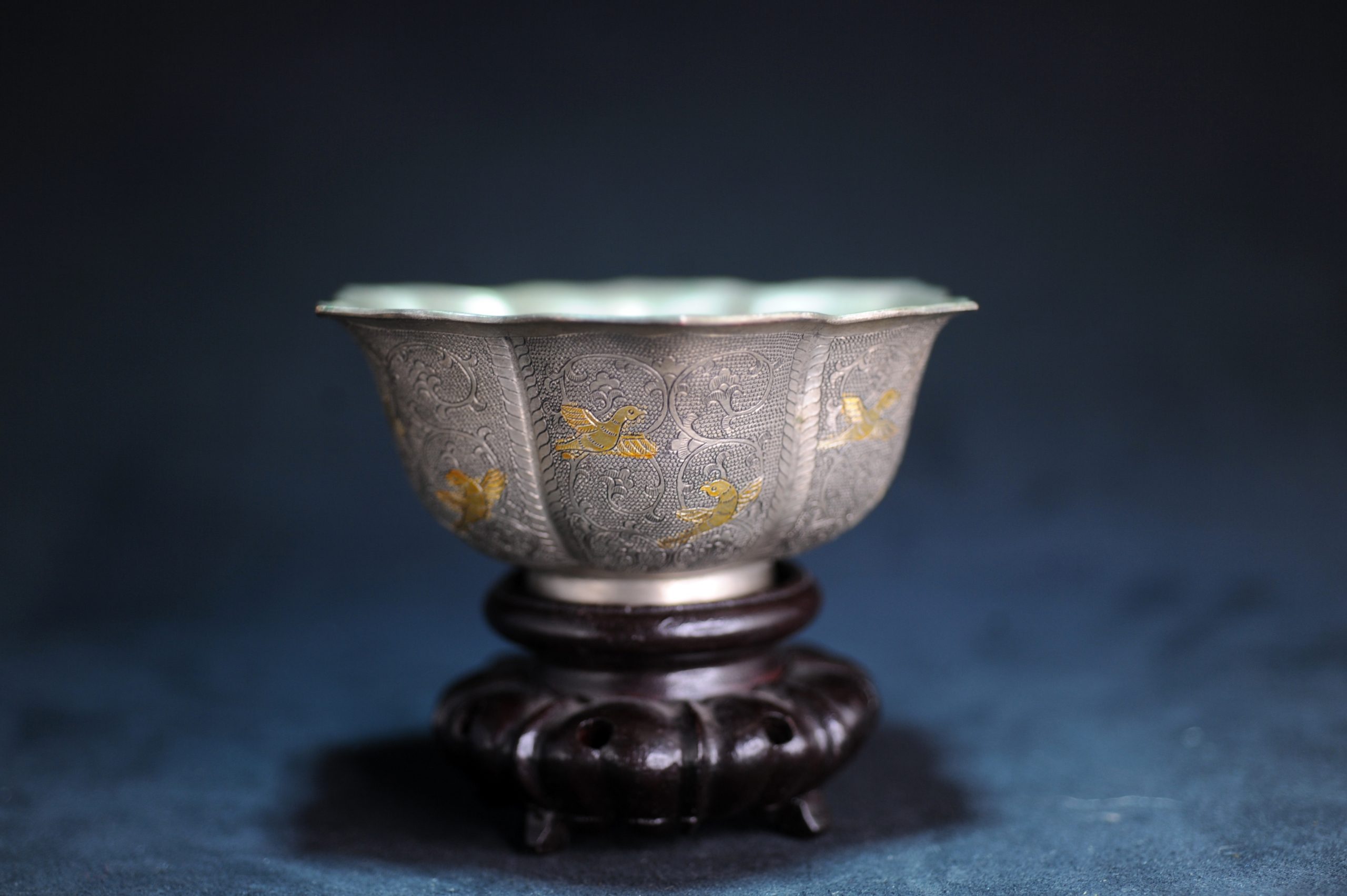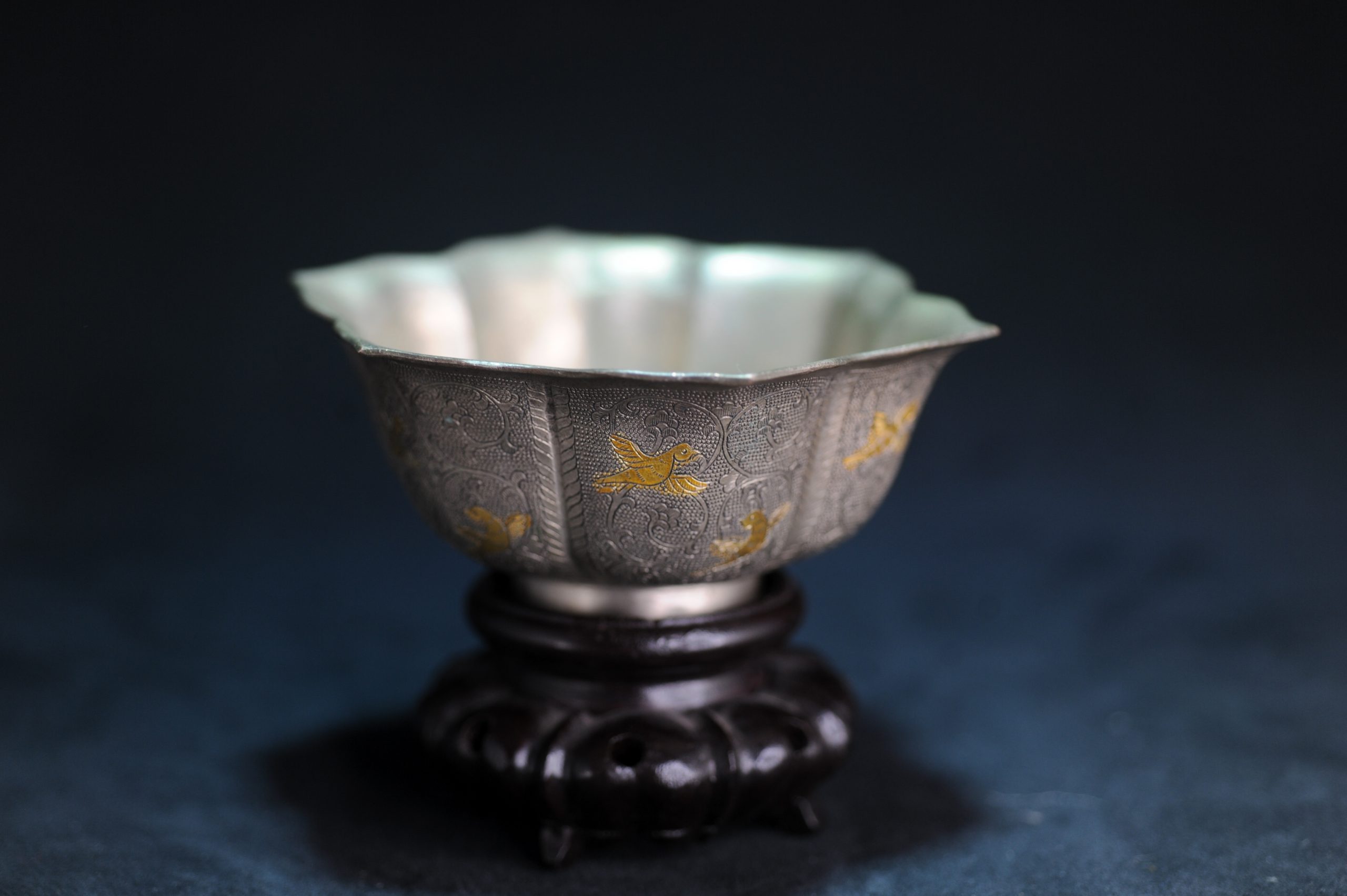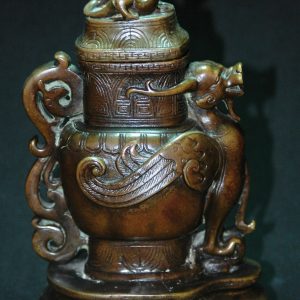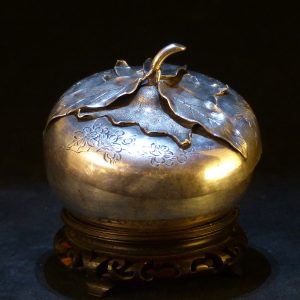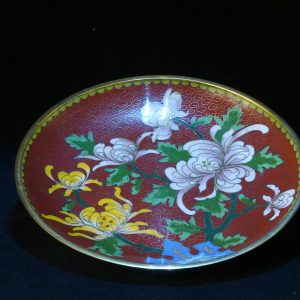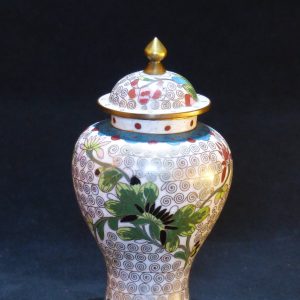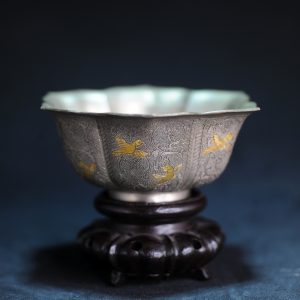Description
唐 錾花鸟纹玉兰银杯
唐 錾银雁穿花紋六曲花口杯
参考:西泠印社2013年春季拍卖会
萃古熙今·文房古玩专场(13春拍)
364明或更早·银鎏金珍珠地花鸟纹碗
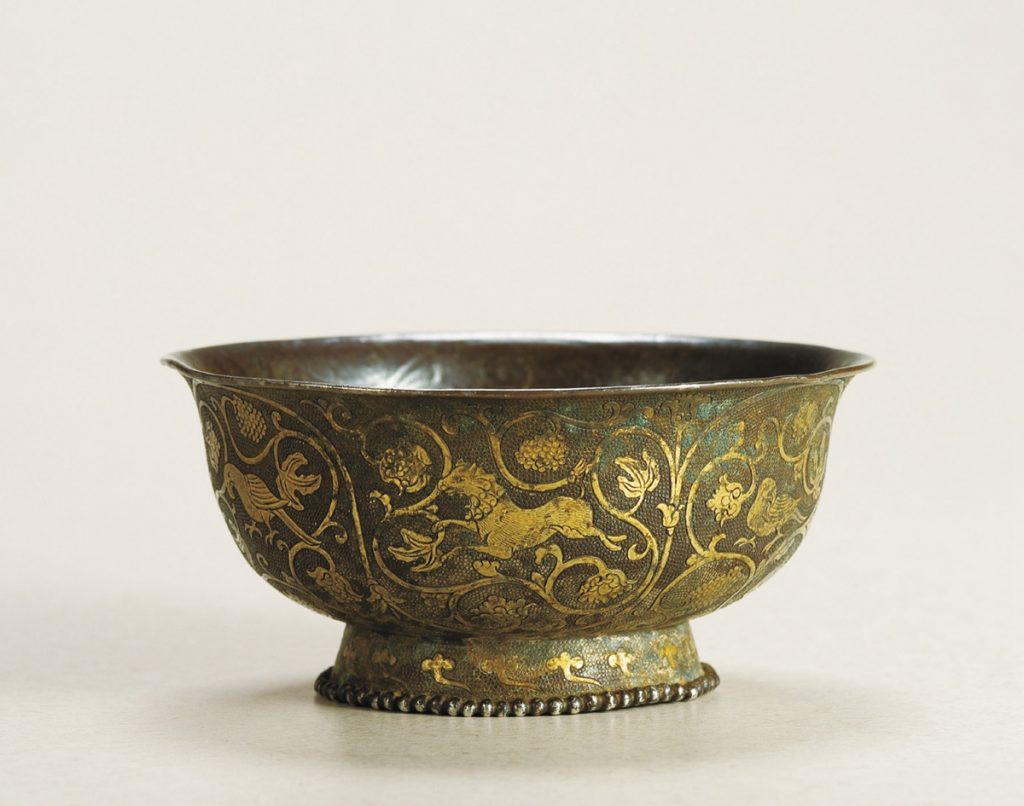
估价RMB: 20,000-40,000
成交价RMB: 40,250(含佣金)
说明:金银器在历史文物中占有重要位置,是中国传统文化艺术的重要载体。金银制品在商代即已出现,春秋战国时代已有金银镶嵌工艺。金银器皿出现较晚,汉以前少见,至唐代由于波斯的影响,有了极大发展。明清以来,金银器多以唐代为本制作。此件银碗口沿外侈,碗身饱满,圈足外撇,碗身以精细的线条錾刻出缠枝花卉,中间有麒麟、鸾凤、天马、锦鸡等祥瑞,足部为祥云纹带,底部亦满工刻花卉飞鸟,通体辅以珍珠纹为地。碗心繁花居中,足底一圈有联珠纹。所有花卉处皆鎏金装饰,形成黄白对比的效果,工艺繁复,精美绝伦。
MING DYNASTY OR EARLIER A GILT SILVER BOWL WITH FLOWER AND BIRD PATTERNS
高:4.7cm 口径:10.2cm
参考:佳士得
現場拍賣 18338
金紫銀青 – 中國早期金銀器粹珍
11 9月 2019
拍品 554 唐 銀局部鎏金鏨刻雁穿花紋四曲小長盃
A FINE SMALL PARCEL-GILT SILVER QUATREFOIL CUP
TANG DYNASTY (AD 618-907)
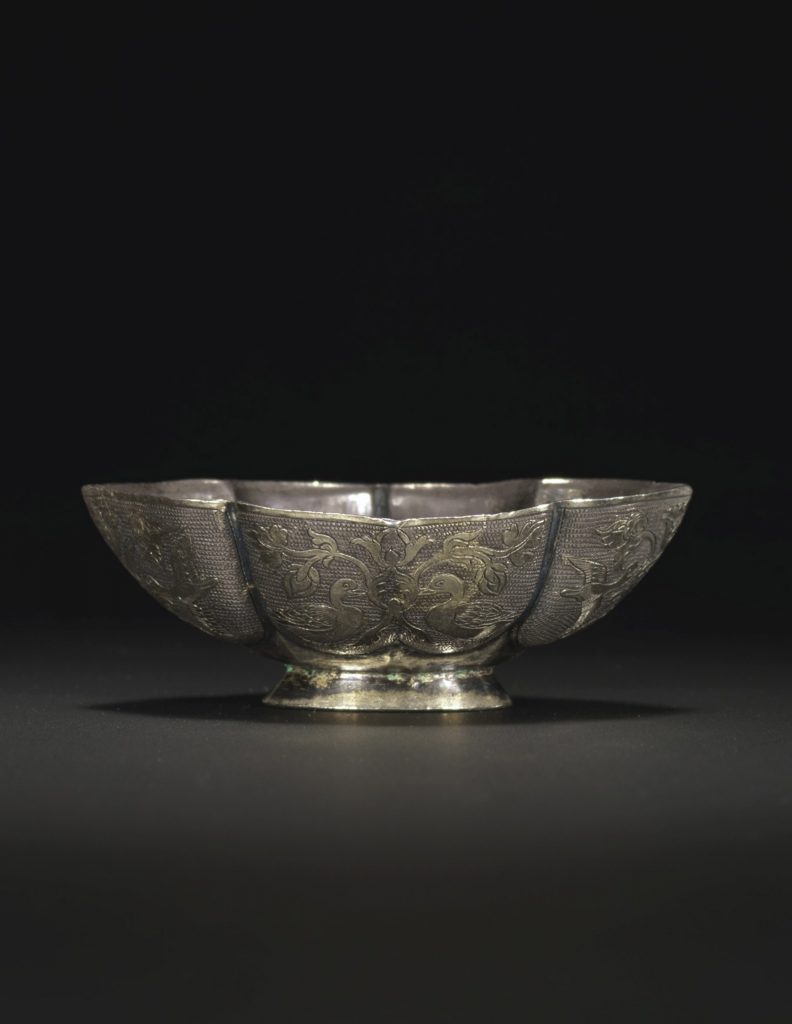
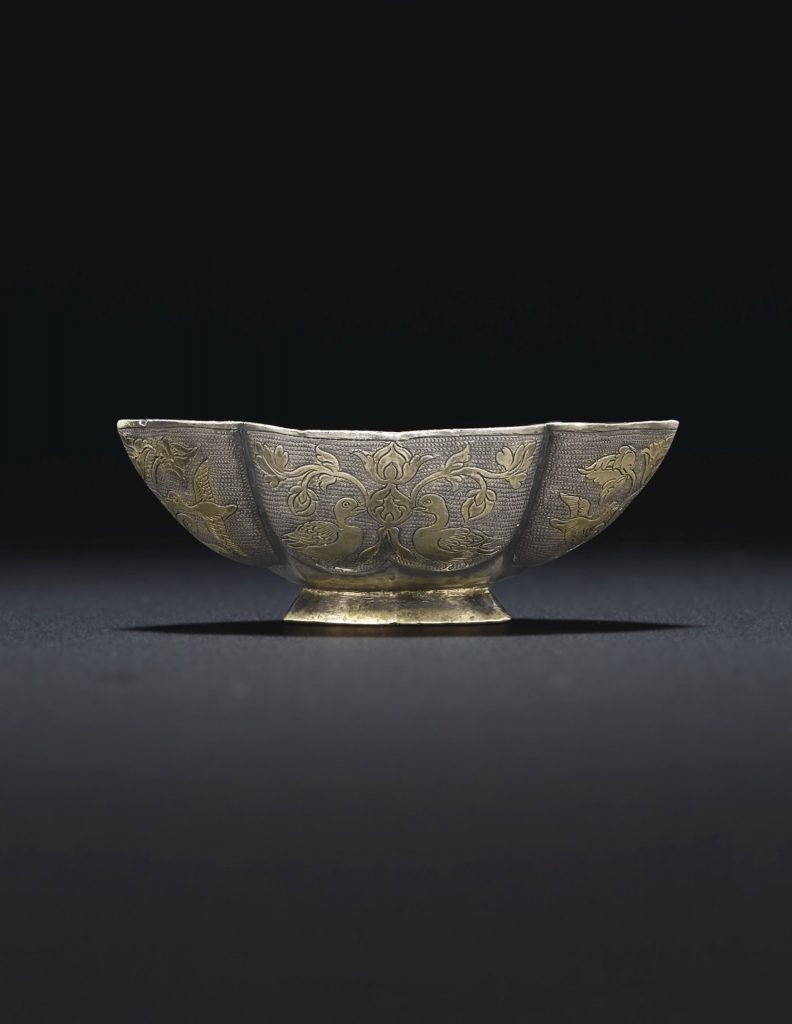
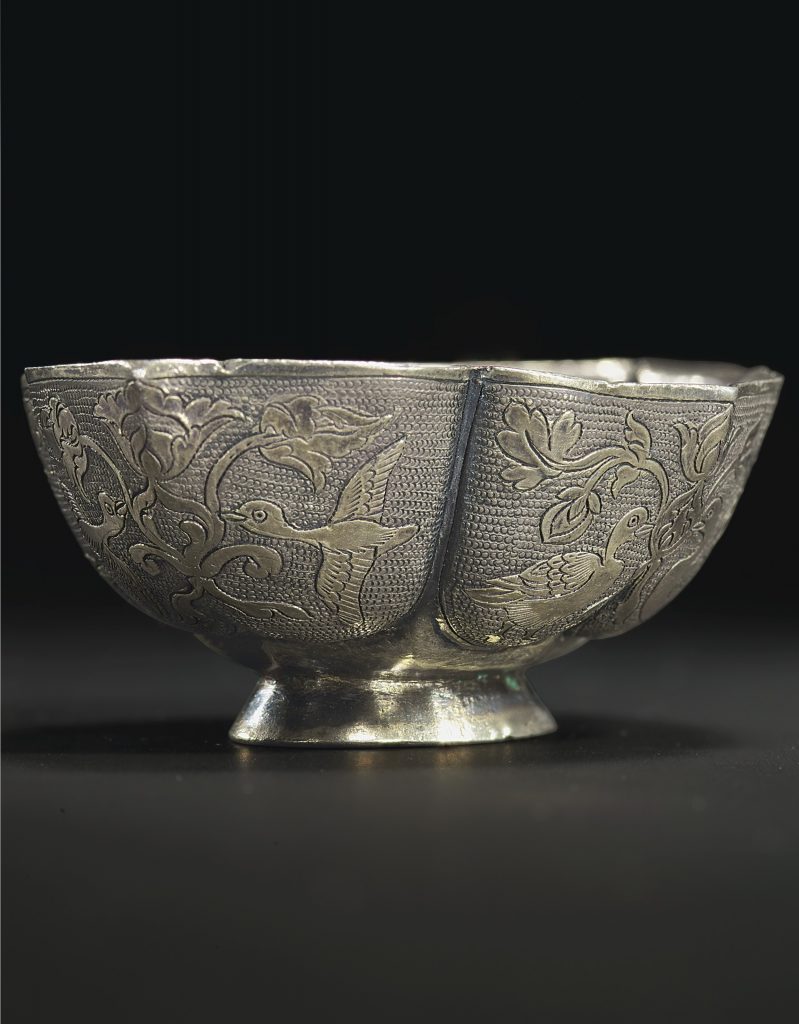
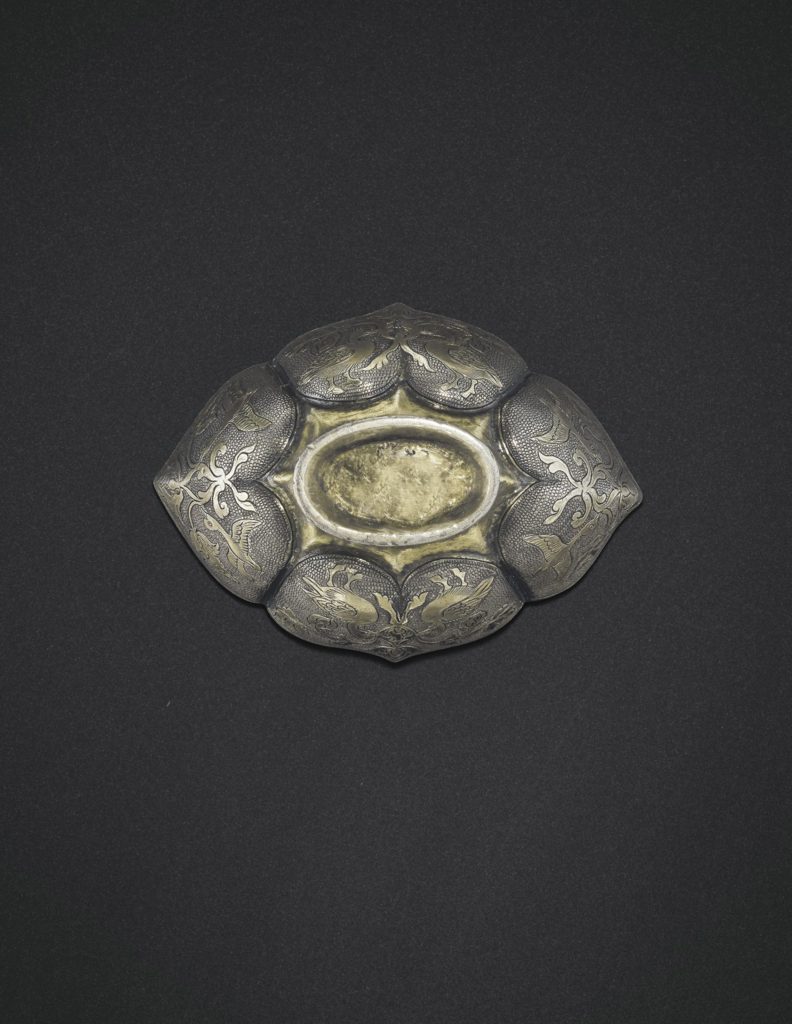
成交價 USD 262,500
估價 USD 50,000 – USD 70,000
細節
唐 銀局部鎏金鏨刻雁穿花紋四曲小長盃
2 ¼ in. ( 5.7 cm.) wide; weight 27.5 g
來源
Dr. Johan Carl Kempe (1884-1967) Collection, Sweden, before 1953, no. CK95.
Sotheby’s London, Masterpieces of Chinese Precious Metalwork. Early Gold and Silver, 14 May 2008, lot 53.
出版
Bo Gyllensvärd, Chinese Gold and Silver in the Carl Kempe Collection, Stockholm, 1953, cat. no. 95.
Bo Gyllensvärd, ‘T’ang Gold and Silver’, Bulletin of the Museum of Far Eastern Antiquities, No. 29, Stockholm, 1957, pl. 11b, fig. 68c, fig. 69a.
Han Wei, Hai nei wai Tangdai jin yin qi cui bian, [Tang Gold and Silver in Chinese and overseas collections], Xi’an, 1989, pl. 82.
Chinese Gold and Silver in the Carl Kempe Collection, The Museum of Art and Far Eastern Antiquities in Ulricehamn, Ulricehamn, 1999, pl. 97.
Qi Dongfang, Tangdai jin yin qi yan jiu [Research on Tang gold and silver], Beijing, 1999, pl. 19.
展覽
Washington, D.C., Smithsonian Institution, Chinese Gold and Silver in the Carl Kempe Collection, 1954-1955, cat. no. 95.
New York, Asia House Gallery, Chinese Gold, Silver and Porcelain. The Kempe Collection, 1971, cat. no. 43, an exhibition touring the United States and shown also at nine other museums.
Oxford, Ashmolean Museum, From Silver to Ceramic, the Potter’s Debt to Metal Work in the Graeco-Roman, Oriental and Islamic Worlds, 1986, pl. 31 (bottom).
狀況報告
– appears to be in overall good condition
– deep, fine scratch to interior of the cup near the base, this does not appear to be a crack
– expected minor nicks and minor dents to the edges
– expected tarnishing and wear, consistent with age
– very minor malachite encrustation to where the cup meets the stem foot
拍品專文
Cups of this oblong, quatrefoil shape appear to be rare. One raised on a higher foot, in the Pierre Uldry Collection, is illustrated in Chinesisches Gold und Silber, Zurich, 1994, p. 152, pl. 138. A larger (11.7 cm. long) quadrilobed bowl with rounded sides, rather than barbed petal lobes, decorated on the exterior with foliate scroll on a ring-punched ground, but raised on a low, quadrilobed foot, in The Frederick M. Mayer Collection of Chinese Art, was sold at Christie’s London, 24-25 June 1974, lot 167. A plain beaten silver quadrilobed bowl with straight, flared sides, its lobes formed by indentations, in the collection of Mr. and Mrs. Rafi Y. Mottahedeh, is illustrated by Dr. Paul Singer, Early Chinese Gold & Silver, China Institute in America, New York, 1971, p. 58, no. 78, where it is dated Tang.
Bowls of lobed oblong shape are more often found with eight lobes, and of larger size, such as the example in the Asian Art Museum of San Francisco, The Avery Brundage Collection, illustrated by Clarence W. Kelley, Tang Dynasty, Chinese Gold & Silver in American Collections, The Dayton Art Institute, Dayton, Ohio, 1984, p. 65, no. 31. Another with eight lobes (15.2 cm. long) is illustrated in Sui to no bijutsu, Osaka Municipal Art Museum, 1976, no. 2-16. The origins of these lobed, oval bowls appear to be Sassanian, as evidenced by the parcel-gilt silver, lobed elliptical bowl raised on a slightly flared, oval foot ring, dated 6th century, illustrated by Ann C. Gunter and Paul Jett, Ancient Iranian Metalwork in the Arthur M. Sackler Gallery and the Freer Gallery of Art, Washington, D.C., 1992, p. 182, pl. 31.
参考: 陕西历史博物馆
“大唐遗宝——何家村窖藏出土文物展”
唐 鎏金仕女狩猎纹八瓣银杯
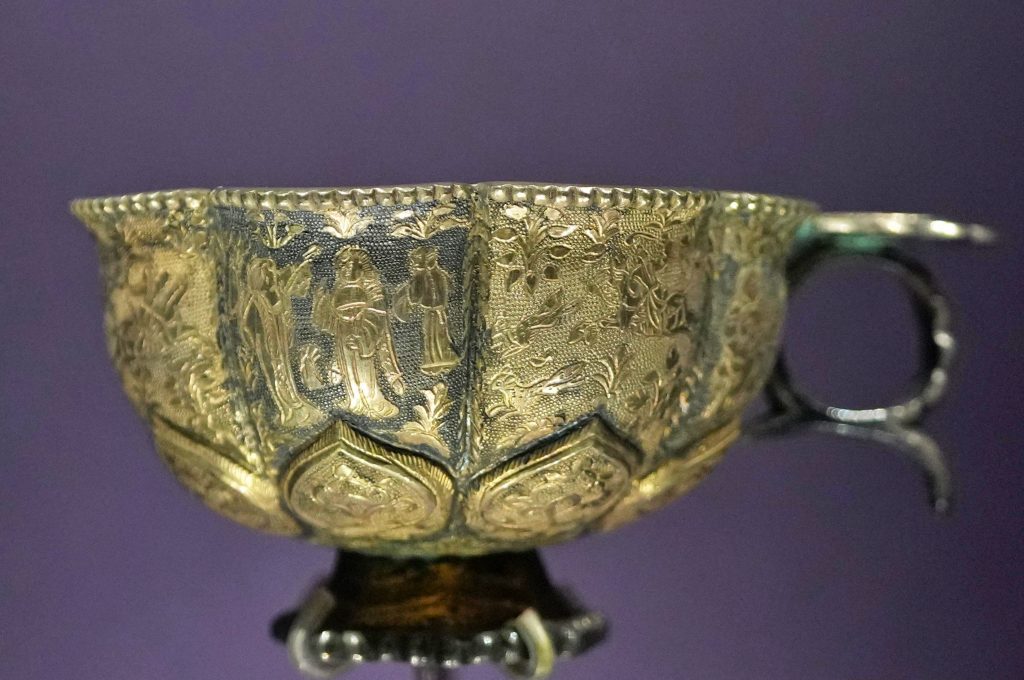
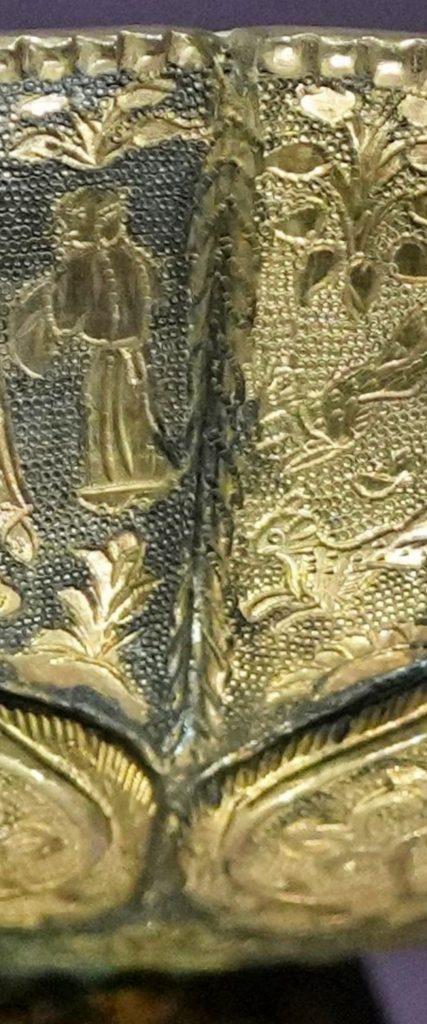
参考:故宫博物院
铜器 新00156333
唐 鎏金錾花花鸟纹葵式银碗
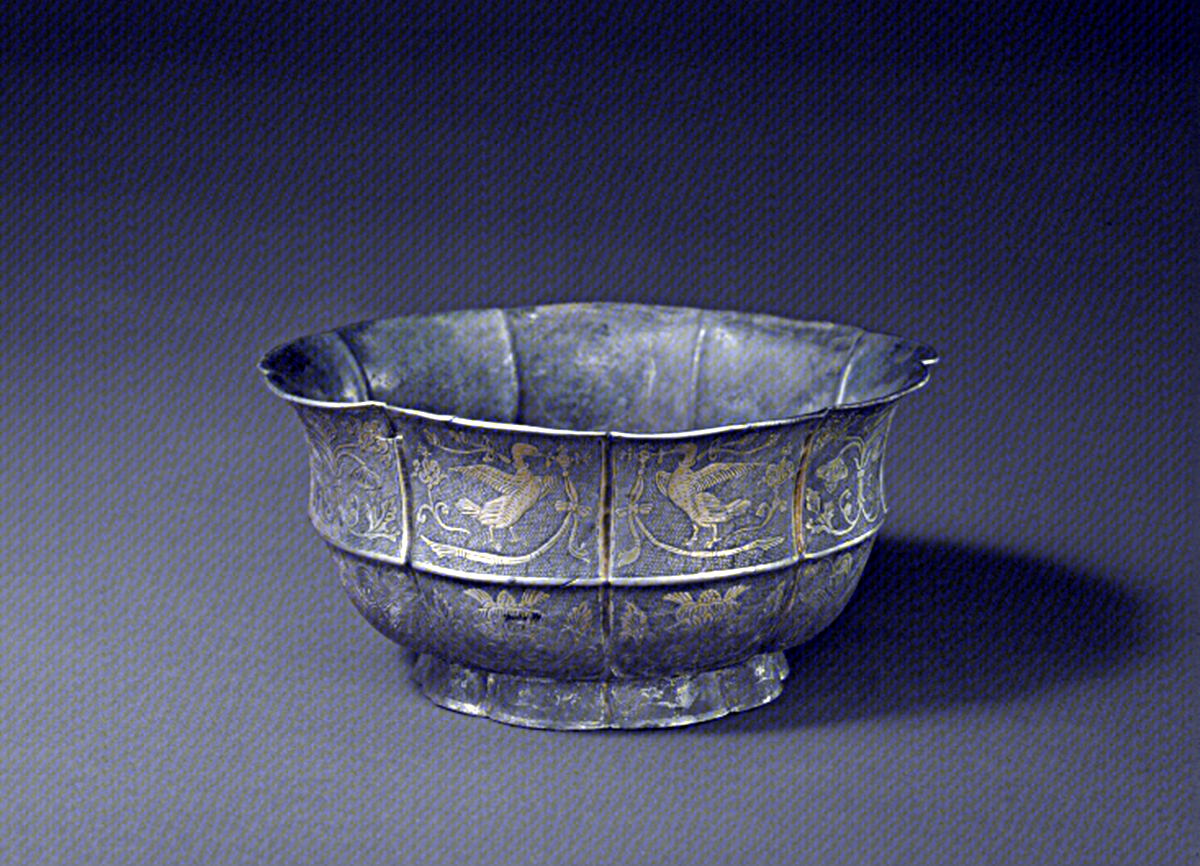
参考: 苏富比
Masterpieces Of Chinese Precious Metalwork,
Early Gold And Silver;
Early Chinese White, Green And Black Wares
14 五月 2008 • 倫敦
拍賣編號: L08211
拍品 51 唐 錾鸿雁卷草纹海棠形鎏金银碗
A RARE BEGONIA-SHAPED PARCEL-GILT SILVER STEMBOWL TANG DYNASTY, 8TH CENTURY
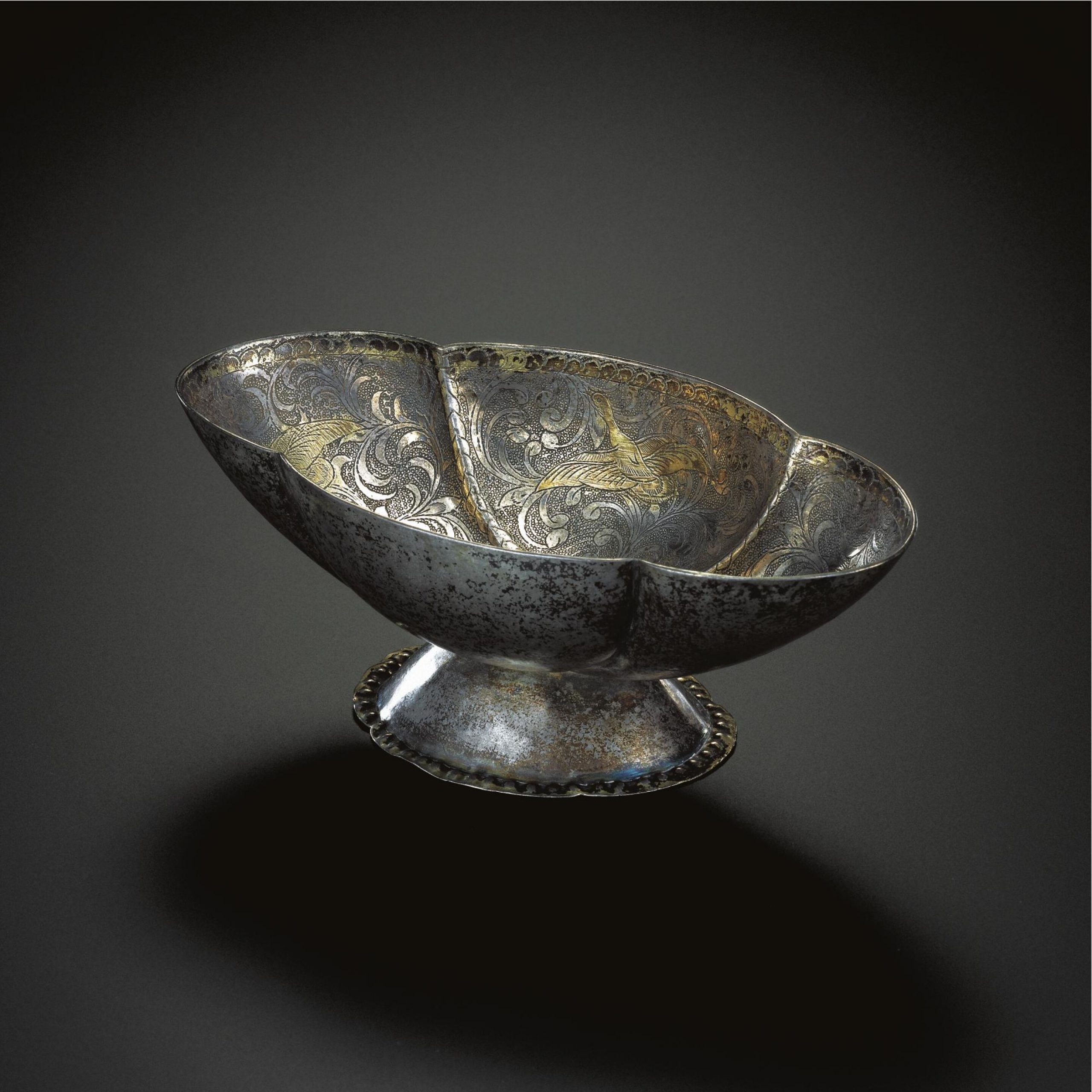 唐 錾鸿雁卷草纹海棠形银碗
唐 錾鸿雁卷草纹海棠形银碗
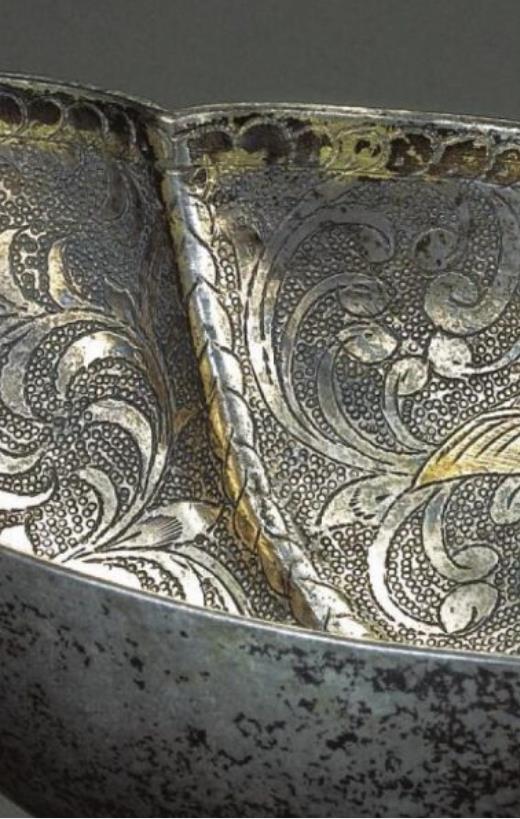
估價 8,000 – 12,000 GBP
已售出 78,500 GBP
描述
15.4cm., 6 1/4 in.
WEIGHT 143g.
参考:耀州窑博物馆藏
北宋 耀州窑柿红釉葵口碗
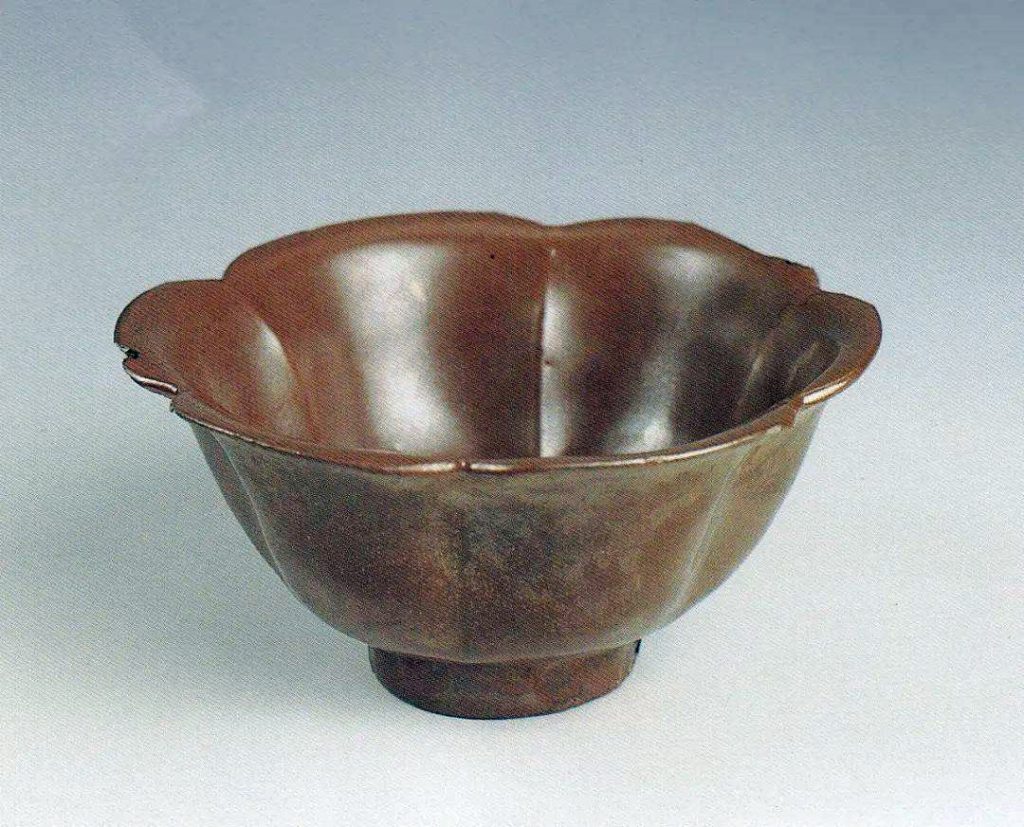
北宋 耀州窑柿红釉葵口碗
耀州窑 通过提高釉的品质来达到类似于漆器的效果。这类瓷器在耀州窑中被叫做“红耀州”。
“红耀州”也叫柿红釉,它的釉色顾名思义,如同柿子一般红彤彤的,这类瓷器和定窑的紫定一样,在当时也算是耀州窑的一个比较高级的产品了。自耀州窑窑址挖掘出来,除了同时期的橄榄绿色的青釉瓷片,就是这类红釉瓷片数量最多,连黑釉瓷片都没有它多,从这生产数量上看就能得知它们在当时是多么的受欢迎。
近年来“红耀州”凭借精巧的造型和如漆似的釉色,成为众藏家心中那一枚朱砂痣,在拍卖场上屡受欢迎。2016年香港佳士得拍出一件耀州窑柿红釉的斗笠碗拍出了25万港币。去年香港苏富比春拍以37.5万港币的价格拍出了一只红耀州斗笠盏。去年保利春拍“十面灵山居”专场的一件耀州窑柿红釉梅瓶,更是拍出了240万的高价,刷新了“红耀州”的拍卖纪录。
参考:苏富比
Masterpieces Of Chinese Precious Metalwork,
Early Gold And Silver;
Early Chinese White, Green And Black Wares
14 五月 2008 • 倫敦
拍賣編號: L08211
拍品 48 唐 錾飞鸟卷草葡萄纹瓜棱花口银碗
A FINE AND RARE LOBED SILVER BOWL TANG DYNASTY, 8TH CENTURY
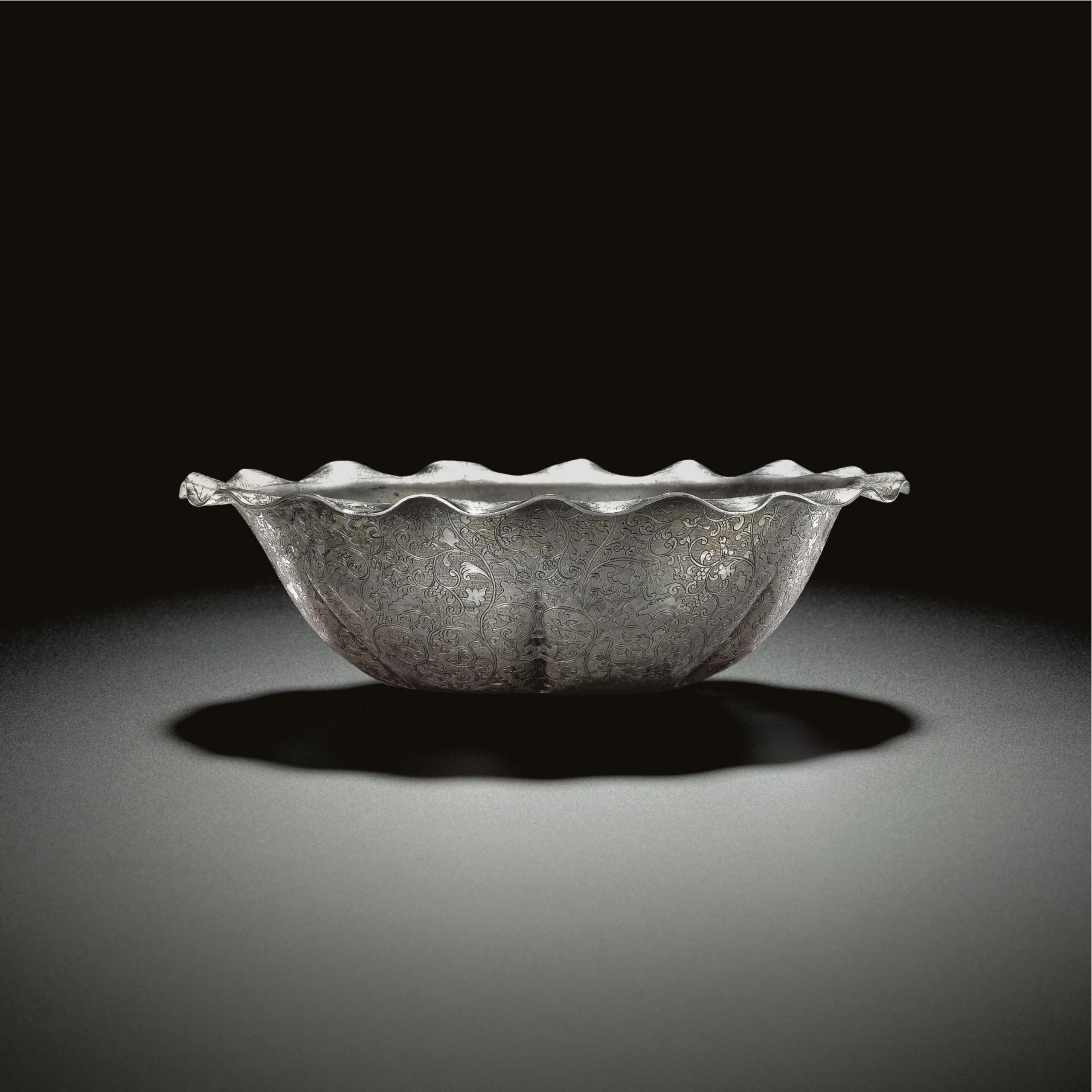
估價 40,000 – 60,000 GBP
已售出 446,100 GBP
描述
17.6cm., 6 7/8 in.
WEIGHT 318.5g.
the shallow bowl of circular shape resting on a flat base, the gently rounded sides indented on the interior dividing the bowl into six lobes, the wavy everted rim rendered to resemble the undulations of a lotus leaf, the interior of the bowl plain, the exterior superbly embellished with a finely engraved overall design of a scrolling vine laden with heavy fruit, symmetrically arranged with the arched, furled leaves forming foliate-shaped medallions, each enclosing a pair of confronting birds, the base finely engraved with six palmette shaped medallions enclosing a strange mythical figure with fox-like head and hoof feet carrying a small animal under his right arm, all reserved on a finely ring-punched ground
展覽
Chinese Gold and Silver in the Carl Kempe Collection, Smithsonian Institution, Washington, D.C., 1954-55, cat. no. 100.
Chinese Gold, Silver and Porcelain. The Kempe Collection, Asia House Gallery, New York, 1971. cat. no. 47, an exhibition touring the United States and shown also at nine other museums.
出版
Bo Gyllensvärd, Chinese Gold and Silver in the Carl Kempe Collection, Stockholm, 1953, pl. 100.
Bo Gyllensvärd, ‘T’ang Gold and Silver’, Bulletin of the Museum of Far Eastern Antiquities, 1957, pl. 29, figs. 43a, 59b, 78n, 80a.
Han Wei, Hai nei wai Tangdai jin yin qi cuibian [Tang gold and silver in Chinese and overseas collections], Xi’an, 1989, pl. 120.
Chinese Gold and Silver in the Carl Kempe Collection, The Museum of Art and Far Eastern Antiquities in Ulricehamn, Ulricehamn, 1999, pl. 102.
拍品資料及來源
It is rare to find silver bowls of this six-lobed form and even rarer are those with a rim fashioned to resemble the natural undulations of a lotus leaf. No other similar example appears to be recorded, although the wavy form is reminiscent of the famous poly-lobed silver bowl, excavated in 1970 from Prince Bin’s treasure hoard at Hejiacun, Shaanxi prvince, illustrated in Han Wei and Christian Deydier, Ancient Chinese Gold, Paris, 2001, pls. 560-561. A silver cover in the form of an inverted lotus leaf, with the edge of the leaf curled up in a wave-like manner, excavated at Dingmaoqiao, Jiangsu province in 1982, is also related in shape to this bowl. This cover can be found in many publications including Tangdai jinyin qi, Beijing, 1985, pl. 229. Further examples of religious objects adorned with lotus petals and with lotus-leaf covers are recorded; for example, see a silver salt holder excavated in 1987 from the Famen Monastery Pagoda at Fufeng county, Shaanxi province, included in Han and Deydier, op.cit., pl. 633; a pair of silver water bowls in the form of lotuses with the foot in the form of large lotus leaves, also from the treasures found in the underground crypt of the Famen Monastery Pagoda, is illustrated ibid., pl. 669.
Mythical figures such as the animal-headed spirit on this bowl are rare on Tang secular silverwork which tends to be decorated with more worldly scenes of daily life such as hunting or performances of music and dancing. The fabulous creature in the centre of the base is closely related to a design of mythical creatures among floral scrolls found on another very fine bowl in the Pierre Uldry Collection and formerly the Frederick M. Mayer Collection, included in the exhibition Chinesisches Gold und Silber, Museum Rietberg, Zurich, 1994, cat. no.143. However, the style of the chased decoration on a ground of ring matting, seen on this vessel, is comparable with the decoration found on a silver bowl, also from the Hejiacun excavation, published ibid., pl. 537.
参考:苏富比
Masterpieces Of Chinese Precious Metalwork,
Early Gold And Silver;
Early Chinese White, Green And Black Wares
14 五月 2008 • 倫敦
拍賣編號: L08211
拍品 51 唐 錾鸿雁卷草纹海棠形鎏金银碗
A RARE BEGONIA-SHAPED PARCEL-GILT SILVER STEMBOWL TANG DYNASTY, 8TH CENTURY

估價 8,000 – 12,000 GBP
已售出 78,500 GBP
描述
15.4cm., 6 1/4 in.
WEIGHT 143g.
the bowl in the shape of a begonia flower rising from a gently spreading quatrefoil foot with a beaded border in repoussé, the interior of the bowl finely engraved and parcel-gilt with a central dragon-fish surrounded by four geese in flight, all amidst large scrolling feathery leaves and reserved on a finely ring-punched ground, the inside rim with a narrow band of overlapping petals
展覽
Chinese Gold and Silver in the Carl Kempe Collection, Smithsonian Institution, Washington, D.C., 1954-55, cat. no. 119.
出版
Bo Gyllensvärd, Chinese Gold and Silver in the Carl Kempe Collection, Stockholm, 1953, pl. 119.
Bo Gyllensvärd, ‘T’ang Gold and Silver’, Bulletin of the Museum of Far Eastern Antiquities, no. 29, 1957, fig. 20j, fig. 98b.
Han Wei, Hai nei wai Tangdai jin yin qi cuibian [Tang Gold and Silver in Chinese and overseas collections], Xi’an, 1989, pl. 90.
拍品資料及來源
Elongated lobed cups of this type with chased decoration are shaped after Sassanian gold and silver prototypes. See Jessica Rawson, ‘Chinese Silver and its Western Origins’, Connoisseur, September 1977, p. 37, where a Tang lobed cup in the British Museum is illustrated, pl. 1, together with a Sassanian type parcel-gilt silver cup with repousse decoration of dancing ladies, stags and grapevine pattern, from the State Hermitage Museum, St. Petersburg, pl. 2.
A related cup, from the Eumorfopoulos collection and now in the Victoria and Albert Museum, London, was included in the exhibition The Arts of the T’ang Dynasty, Los Angeles County Museum, 1957, cat.no. 339; and another, on loan at the Virginia Museum and University Museum, Philadelphia, was sold in our New York rooms, 4th June 1986, lot 242.
Compare also a cup of quatrefoil form with a similar saw-edge pattern around the foot, from the Mayer Collection, its line drawing illustrated in Bo Gyllensvard, Tang Gold and Silver, Bulletin of the Museum of Far Eastern Antiquities, no. 29, 1957, fig. 20m, and included in the exhibition Chinese Art in the Minor Dynasties and T’ang, China House, New York, 1950, sold at Christie’s London, 24/25th June 1974, lot 167; and an eight-lobed cup from the collection of Dr. Pierre Uldry included in the exhibition Chinesisches Gold und Silber, Rietberg Museum, Zurich, 1994, cat. no. 139.
参考:苏富比
Masterpieces Of Chinese Precious Metalwork,
Early Gold And Silver;
Early Chinese White, Green And Black Wares
14 五月 2008 • 倫敦
拍賣編號: L08211
拍品 53 唐 錾鸿雁卷草纹鎏金银碗
A FINE SMALL PARCEL-GILT SILVER BOWL
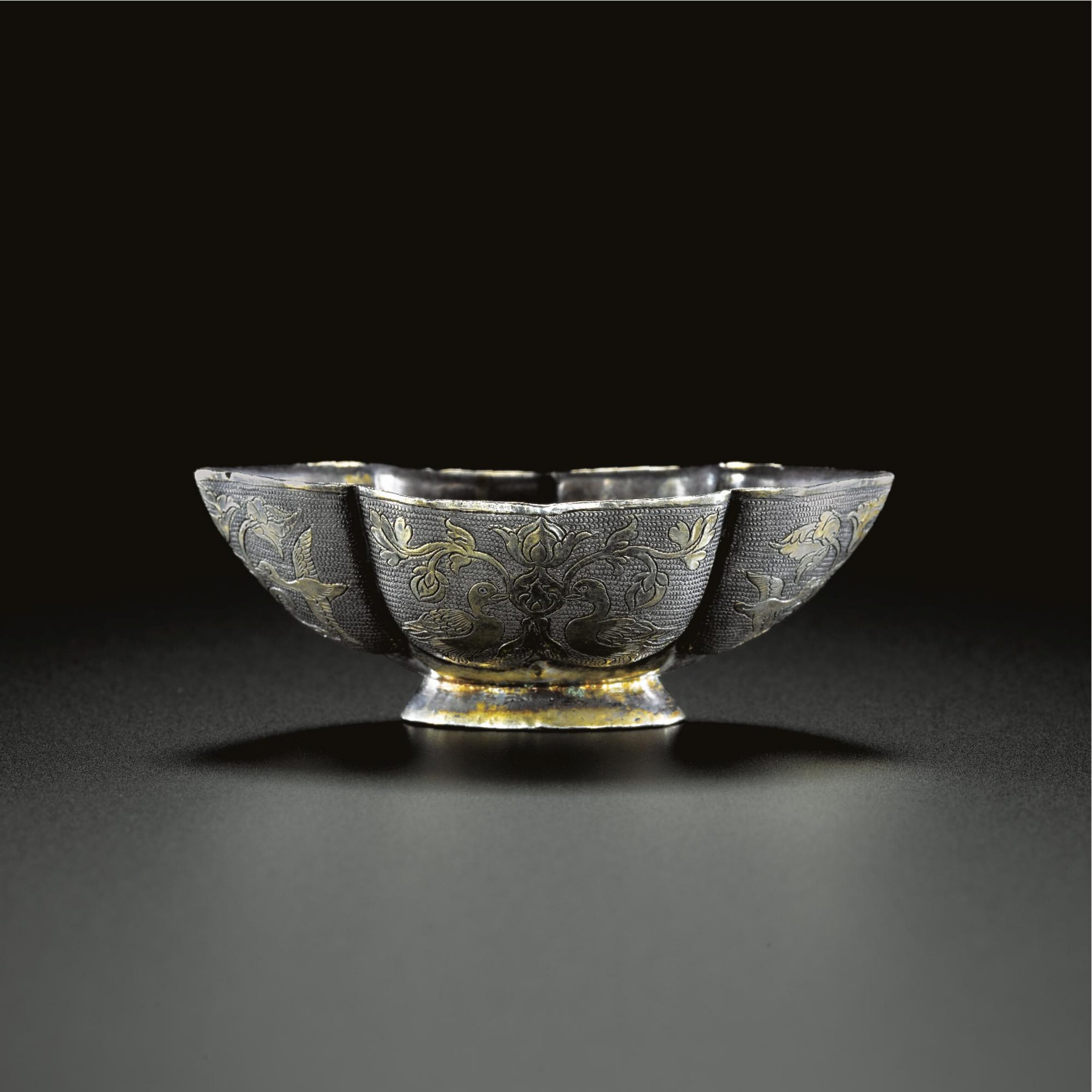
估價 10,000 – 15,000 GBP
已售出 36,500 GBP
描述
5.7cm., 2 1/4 in.
WEIGHT 27.5g.
of elegant oblong form and with a bracketed quatrefoil outline, the lobed sides rising from a slightly flared short foot, each lobe superbly engraved and parcel-gilt with a confronting pair of ducks separated by an elaborate conjoined spray of flowers crowned by a large flower head, all on a very finely executed ground of ring-matting, the centre of the interior and base gilt and undecorated
展覽
Chinese Gold and Silver in the Carl Kempe Collection, Smithsonian Institution, Washington, D.C., 1954-55, cat. no. 95.
Chinese Gold, Silver and Porcelain. The Kempe Collection, Asia House Gallery, New York, 1971, cat. no. 43, an exhibition touring the United States and shown also at nine other museums.
From Silver to Ceramic, the Potter’s Debt to Metal Work in the Graeco-Roman, Oriental and Islamic Worlds, Ashmolean Museum, Oxford, 1986, pl. 31 (bottom)
出版
Bo Gyllensvärd, Chinese Gold and Silver in the Carl Kempe Collection, Stockholm, 1953, pl. 95.
Bo Gyllensvärd, ‘T’ang Gold and Silver’, Bulletin of the Museum of Far Eastern Antiquities, no. 29, 1957, pl. 11b, fig. 68c, fig. 69a.
Han Wei, Hai nei wai Tangdai jin yin qi cuibian [Tang Gold and Silver in Chinese and overseas collections], Xi’an, 1989, pl. 82.
Chinese Gold and Silver in the Carl Kempe Collection, The Museum of Art and Far Eastern Antiquities in Ulricehamn, Ulricehamn, 1999, 97.
拍品資料及來源
Bowls of this elegantly pronounced, lobed quatrefoil form shaped after Persian silver and gold drinking vessels, are extremely rare. A stylistically related bowl of similar section is illustrated in Hugh Scott, The Golden Age of Chinese Art. The Lively T’ang Dynasty, Rutland, Vermont, 1967, pl. 77, now in the Pierre Uldry collection and included in the exhibition Chinesisches Gold und Silber, Museum Rietberg, Zurich, 1994, cat. no. 138. See also a lobed bowl excavated at Taiyi Road in Xi’an, published in Tangdai jinyin qi, Beijing, 1985, pls. 245-246, together with another lobed oblong vessel, pl. 262.
A plain silver quatre-lobed bowl with indentations similar at the rim from the collection of Mr. and Mrs. Mottahedeh, was included in the China Institute in America exhibition Early Chinese Gold and Silver, China House Gallery, New York, 1971, cat. no. 78, together with a bowl of octafoil shape, pl.79, from the Metropolitan Museum of Art, New York.
参考:西泠印社
2018年春季拍卖会
中国历代瓷器专场
图录号: 4090 宋·耀州窑刻花花口盏
SONG DYNASTY A ‘YAOZHOU’ TEA BOWL WITH FLORAL PATTERN
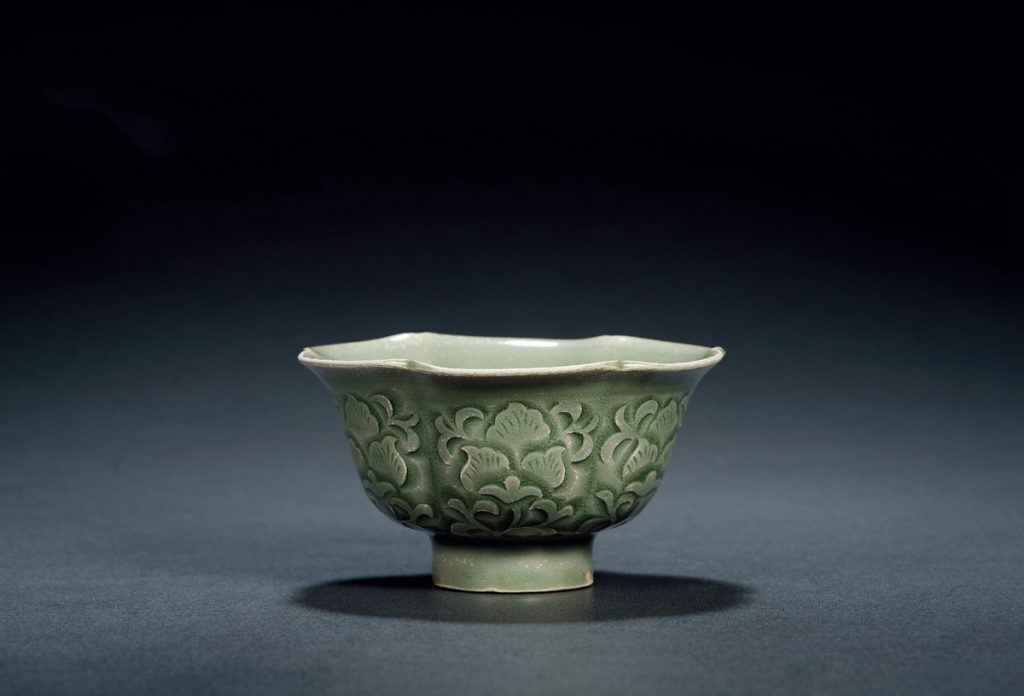
估价RMB: 20,000-30,000
成交价RMB: –(含佣金)
宋·耀州窑刻花花口盏
说明:此碗呈六出花口,盘壁每一瓣均向内凹,宛如一朵盛开的梅花。内外施青釉,釉色青绿,润莹亮泽,玻璃质感较强。外壁剔刻折枝牡丹花,刀工犀利深邃。
高:6.1cm口径:11.8cm
RMB: 20,000-30,000
参考:邵武市文物管理委员会藏
南宋 鎏金人物八角银杯
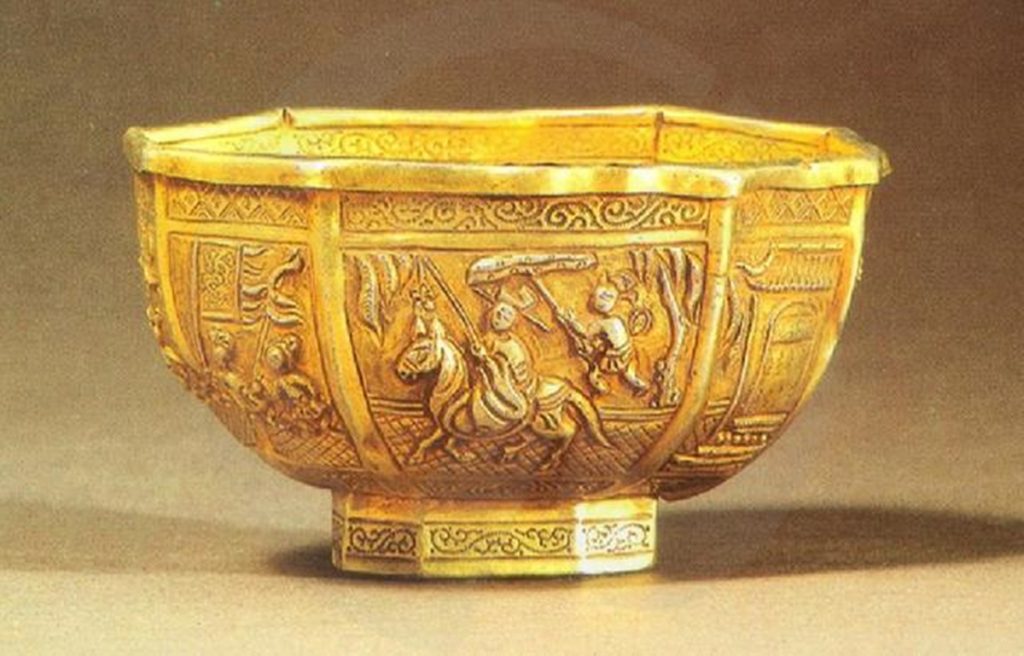
高5.5厘米 口径7.5-9.3厘米 足径3.5厘米 重56克
1980年福建邵武出土
酒器。银质,鎏金。八角形,双层器壁,圈足。
内壁口沿下錾饰卷草纹带一周。杯心錾刻《踏莎行》词一首,外壁分八楞,每楞上下端分别錾饰卷草、方胜、如意头等花边,中部压印出凸起的故事图样,分别表现杯心《踏莎行》词意。杯足錾饰卷草纹。造型优美,技艺精湛,为宋代银器中所
参考:邵武市博物馆藏
年代:南宋 金葵形圈足杯
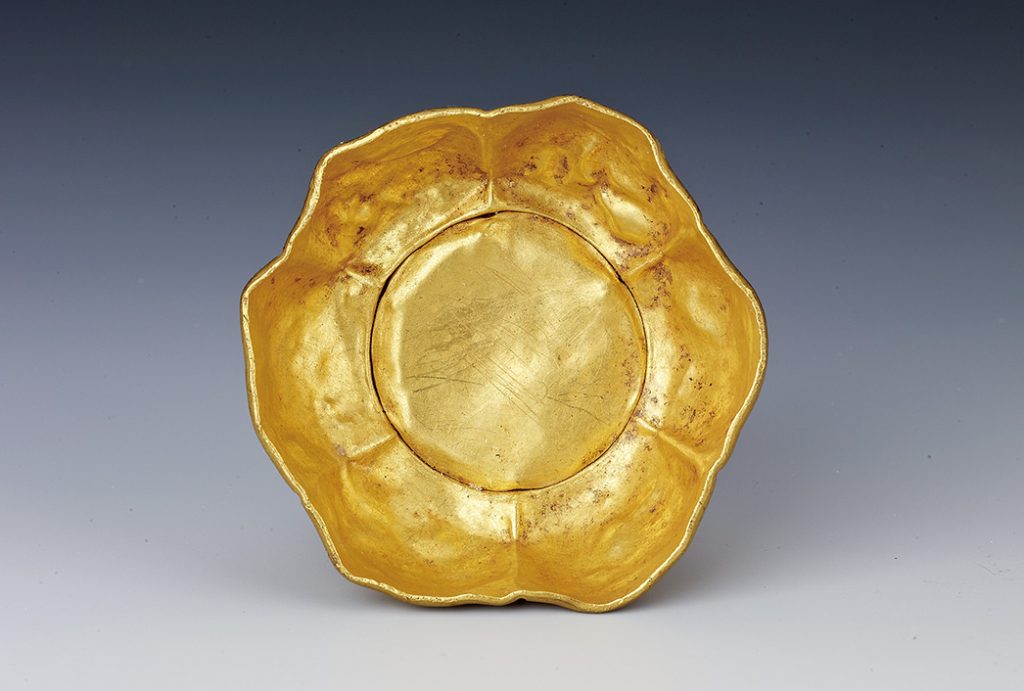
规格:口径7.4、底径4.1、高3.1CM
来源:1980年邵武庵窠窖藏出土
描述
六出葵口,弧腹,矮圈足。素面,色泽金黄,内壁捶打、錾压出筋,杯身与圈足二部分镶嵌连接成形。
参考:邵武市博物馆藏
年代:南宋 鎏金银錾花六出莲花杯
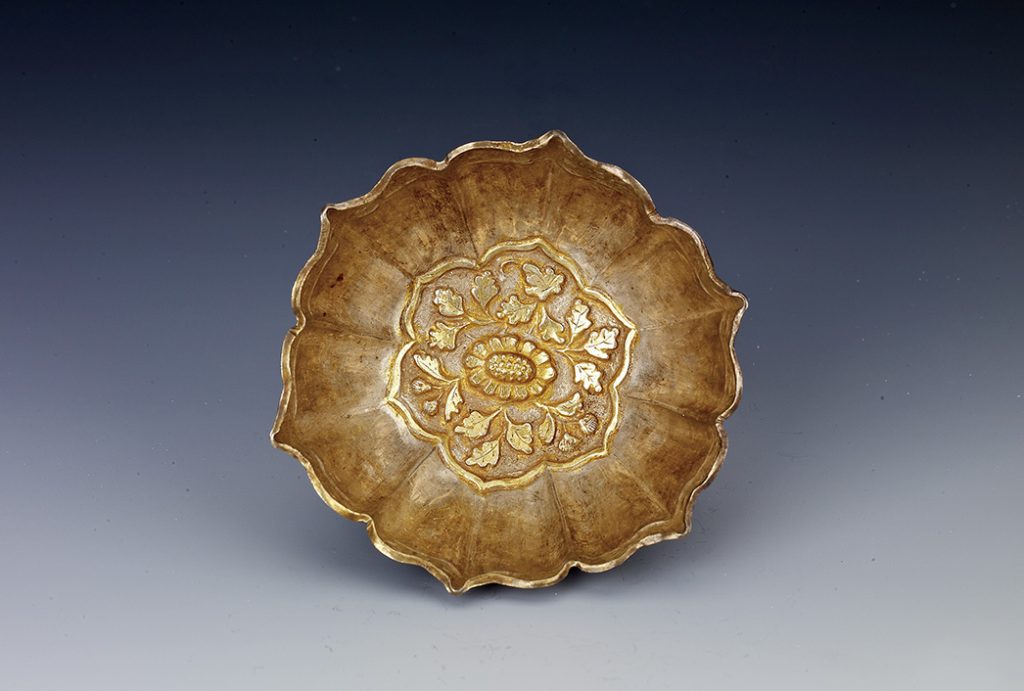
规格:口径9、底径4.5、高5.5CM
来源:1980年邵武庵窠窖藏出土
描述
银质。六出莲花口,弧腹,圈足外撇,杯身作六瓣莲花状,内壁口沿下錾压凸起12组折枝花卉图案,杯心錾压凸起折枝菊花图案。口沿与杯心折枝菊花图案处鎏金。
参考:邵武市博物馆藏
年代:南宋
鎏金银錾花梅梢月纹花口杯
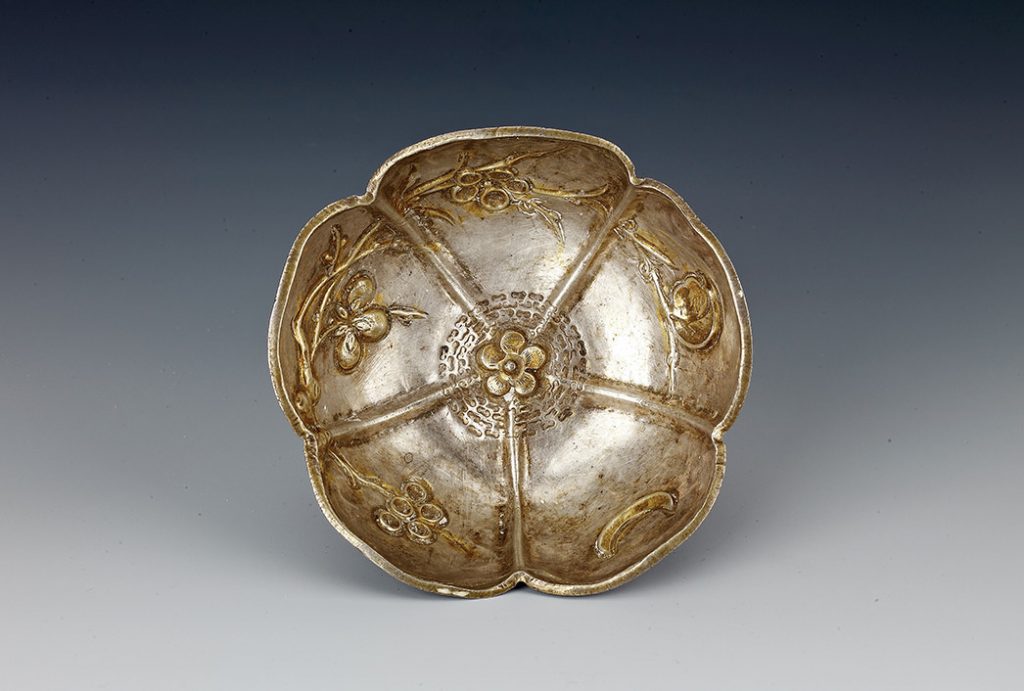
鎏金银錾花梅梢月纹花口杯
规格:口径9.5、底径4.5、高5.6CM
来源:1980年邵武庵窠窖藏出土
描述
银质。口沿及图案凸起部分鎏金,梅花口,弧腹,梅花足,杯内錾压纹饰如浮雕,腹部饰梅花树、弯月,底中心饰五瓣梅花一朵,梅花旁錾刻“3”形水波纹意寓湖面。整个画面为梅花临水,新月当空场景,极具诗意。杯足近底处,还錾饰弧线、花卉图案点缀。
参考:邵武市博物馆藏
年代:南宋
鎏金银“踏莎行”人物故事八角杯
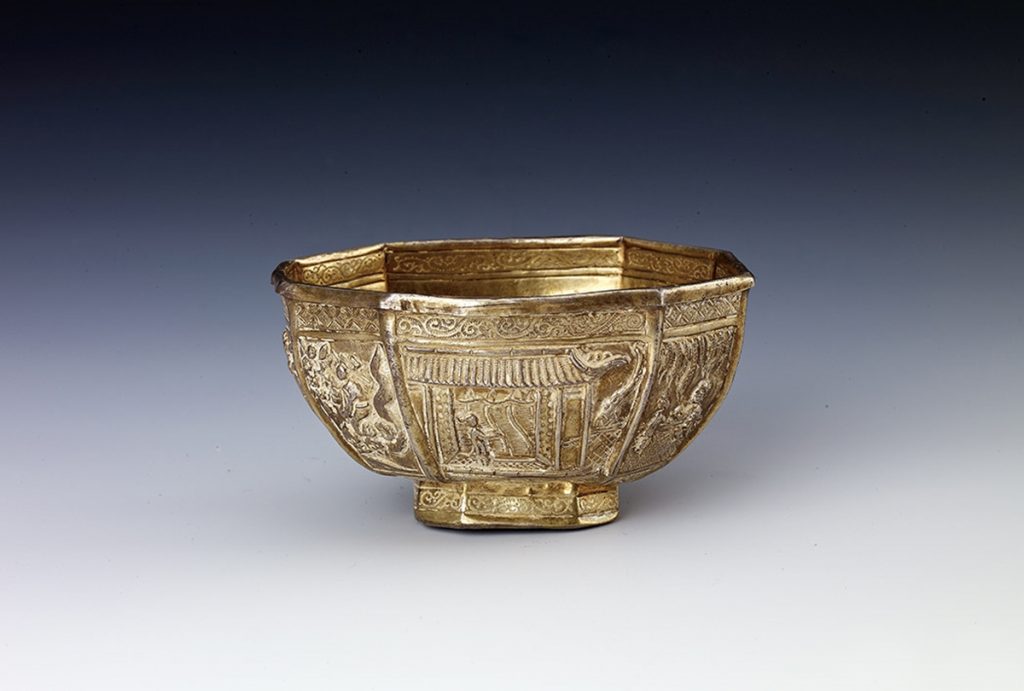
规格:口径8-9.5、底径2.8-4.2、高5.5CM
来源:1980年邵武庵窠窖藏出土
描述
银质,通体鎏金,八角口,卷沿,深腹,八角足,器内近口沿处錾刻弦纹、卷草图案一周,杯心錾刻《踏莎行》词一首,纵向楷书,共十行,錾点成字,每行字数不等,计六十一字。全文如下:足蹑云梯,手攀仙桂,姓名高挂登科记。马前喝到(道)状元来,金鞍玉勒成行对。宴罢琼林,醉游花市,此时方显平生至(志)。修书速报凤楼人,这回好个风流婿。踏莎行。器外壁分八面开光,每面分上中下三格。上格錾刻卷草、金子芽图案,下格錾刻如意头、卷草图案。中格较大,分别压印凸花画面,有人物、花卉、房屋、骑马出行等场景。杯足外錾刻弦纹、卷草图案。
参考:邵武市博物馆藏
南宋 银鎏金花式盏(两件)
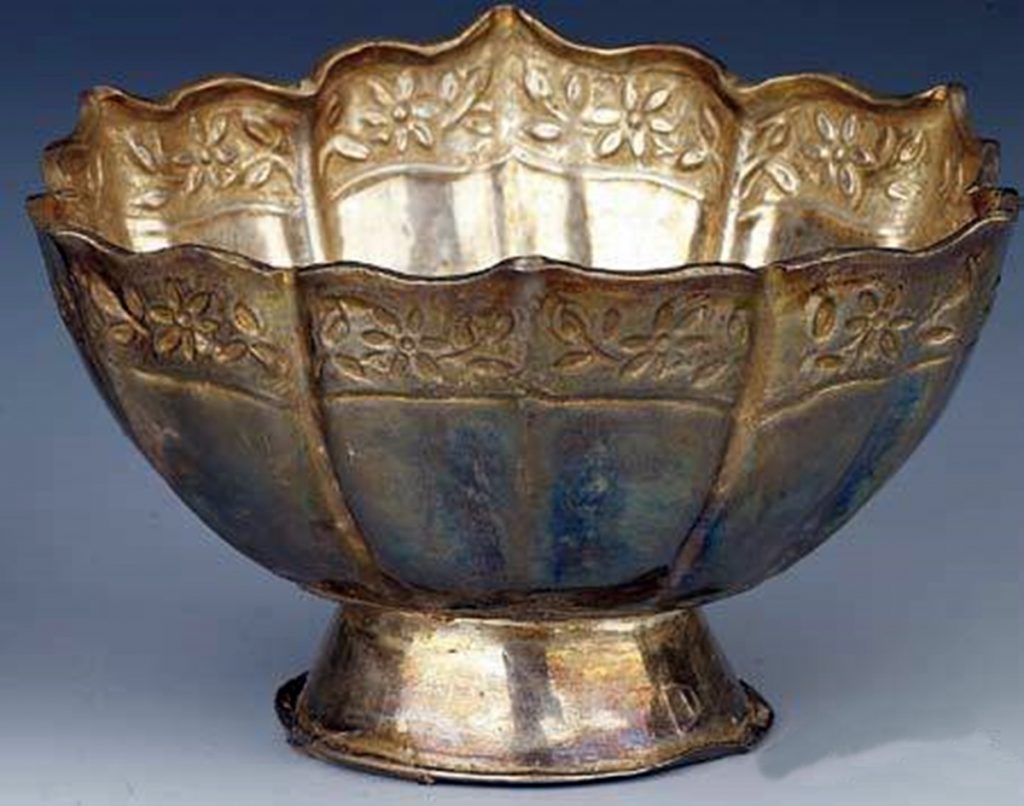
口径8.5厘米,高5.5厘米
福建邵武故县银器窖藏出土
出土一组八件。盏作六瓣菱花形,内壁口沿下饰连续六瓣花卉纹一周,盏心纹饰每盏各异,分别为菊花、葵花、牡丹等。附圈足,足外撇。口沿与盏心纹饰皆鎏金。
参考:邵武市博物馆藏
南宋 银鎏金梅梢月纹盘盏(一副)
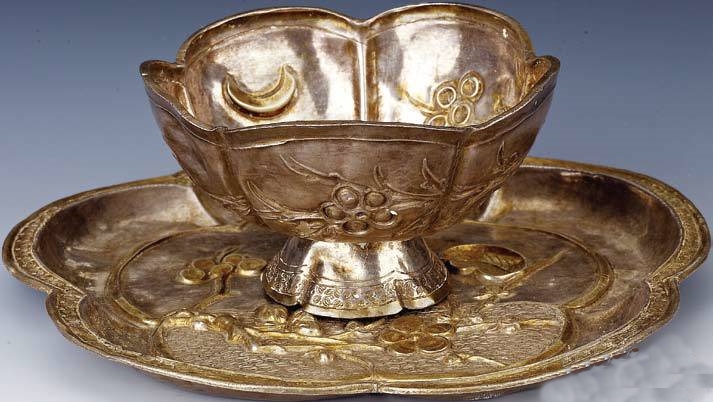
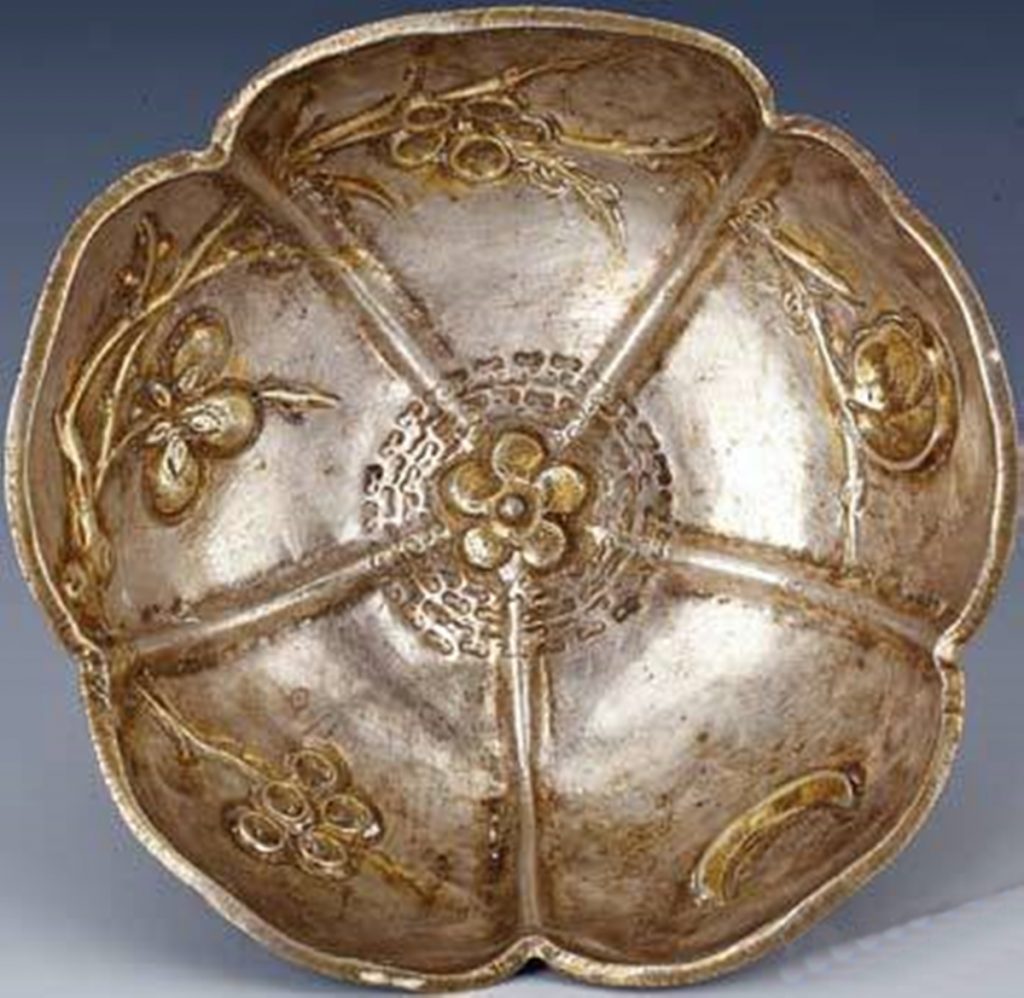
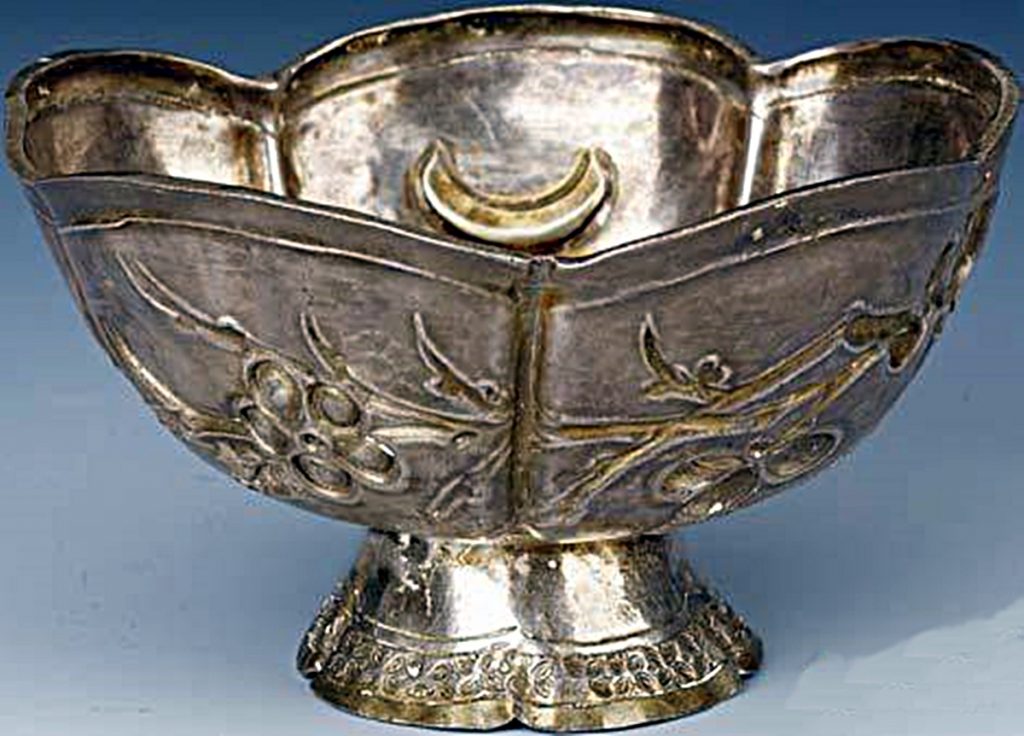
盘径15.8厘米,高1.2厘米
盏径9.1厘米,高5.1厘米
福建邵武故县银器窖藏出土
梅梢月纹盘、盏各一件。皆作五瓣梅花形,盘底无足,宽沿。盘内与盏内皆锤揲鎏金凸花如浮雕,画面为梅花临水,新月当空。盏底附五瓣花形空足。
参考:佳士得
2019年9月11日 | 現場拍賣 18338
金紫銀青 – 中國早期金銀器粹珍
唐 銀花鳥紋蓮瓣式小高足盃
TANG DYNASTY (AD 618-907)
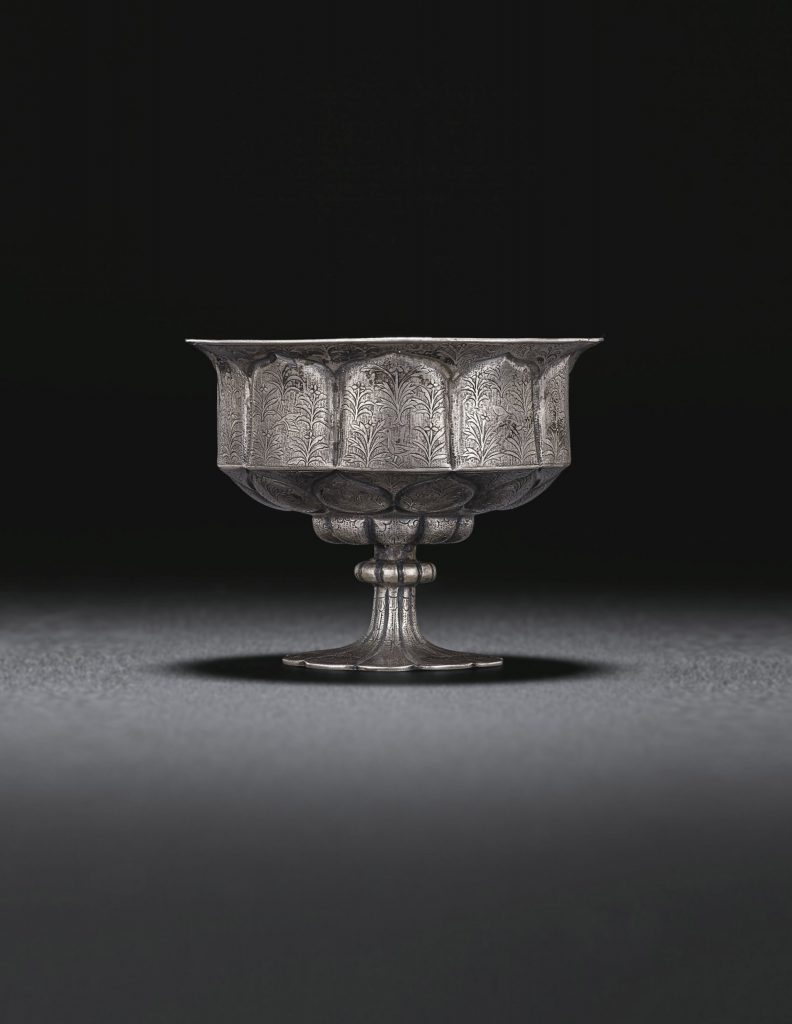
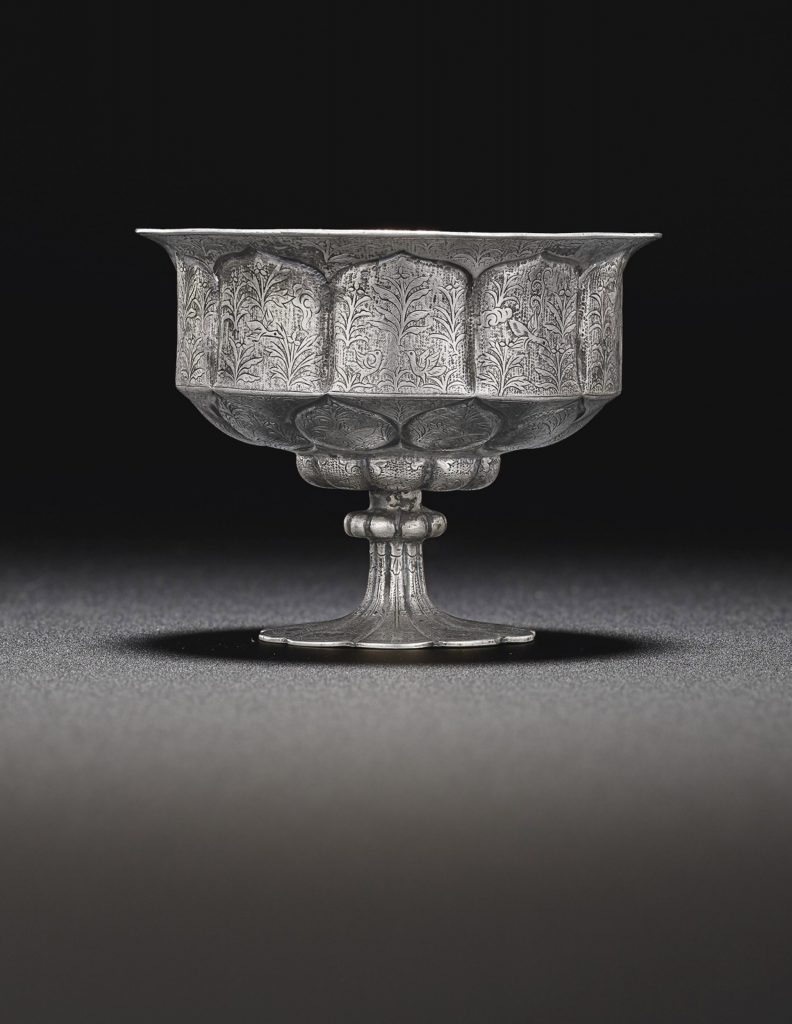
成交價USD 68,750
估價USD 50,000 – USD 70,000
細節
唐 銀花鳥紋蓮瓣式小高足盃
2 ¾ in., (7 cm.) diam.; weight 53 g
來源
Dr. Johan Carl Kempe (1884-1967) Collection, Sweden, before 1953, no. CK111.
Sotheby’s London, Masterpieces of Chinese Precious Metalwork. Early Gold and Silver, 14 May 2008, lot 71.
出版
Bo Gyllensvärd, Chinese Gold and Silver in the Carl Kempe Collection, Stockholm, 1953, cat. no. 111.
Han Wei, Hai nei wai Tangdai jin yin qi cuibian [Tang Gold and Silver in Chinese and overseas collections], Xi’an, 1989, pl. 53.
Qi Dongfang, Tangdai jin yin qi yan jiu [Research on Tang gold and silver], Beijing, 1999, p. 402, fig. 3-107-4.
展覽
Washington, D.C., Smithsonian Institution, Chinese Gold and Silver in the Carl Kempe Collection, 1954-55, cat. no. 111.
狀況報告
We have sought to record changes in the condition of this piece acquired after its initial manufacture.
– a small section of repair to one upright petal
– several small cracks and a few tiny holes along the edges of the lotus petals beneath the rim
– expected light surface abrasion and wear, and tarnishing to the metal
拍品專文
Several silver cups of this elegant shape, similarly decorated on each lobe with various birds in flight amidst plants, have been published. One in the Hakutsuru Art Museum, Kobe, Japan, is illustrated by B. Gyllensvärd, ‘T’ang Gold and Silver’, B.M.F.EA., No. 29, Stockholm, 1957, pl. 4b. Another from the Arthur M. Sackler Collections, and previously in the David Weill Collection, was sold at Christie’s New York, 1 December 1994, lot 65. One is illustrated in Tangdai jin yin qi, Zhejiang Municipal Museum and Shaanxi Provincial Museum, 1985, figs. 7 and 8; and another was included in the exhibition, Masterpieces of Chinese Art From the Art Institute of Chicago, Osaka, Japan, Museum of Oriental Ceramics, 1989, no. 25. Two gilt-bronze examples have also been published: one in the collection of Dr. Pierre Uldry, Chinesisches Gold und Silber, Zurich, 1994, p. 151, no. 136; the other in the St. Louis Art Museum, by Clarence W. Kelley, Chinese Gold & Silver in American Collections, The Dayton Art Institute, Dayton, Ohio, 1984, p. 54, no. 20. The decoration on all of these cups is highly formal in its symmetry.
参考:佳士得
2019年9月11日 | 現場拍賣 18338
金紫銀青 – 中國早期金銀器粹珍
拍品 543 晚唐/遼 銀鳳穿花紋八稜盃
A SILVER OCTAGONAL ‘PHOENIX’ CUP
LATE TANG-LIAO DYNASTY, 9TH-12TH CENTURY
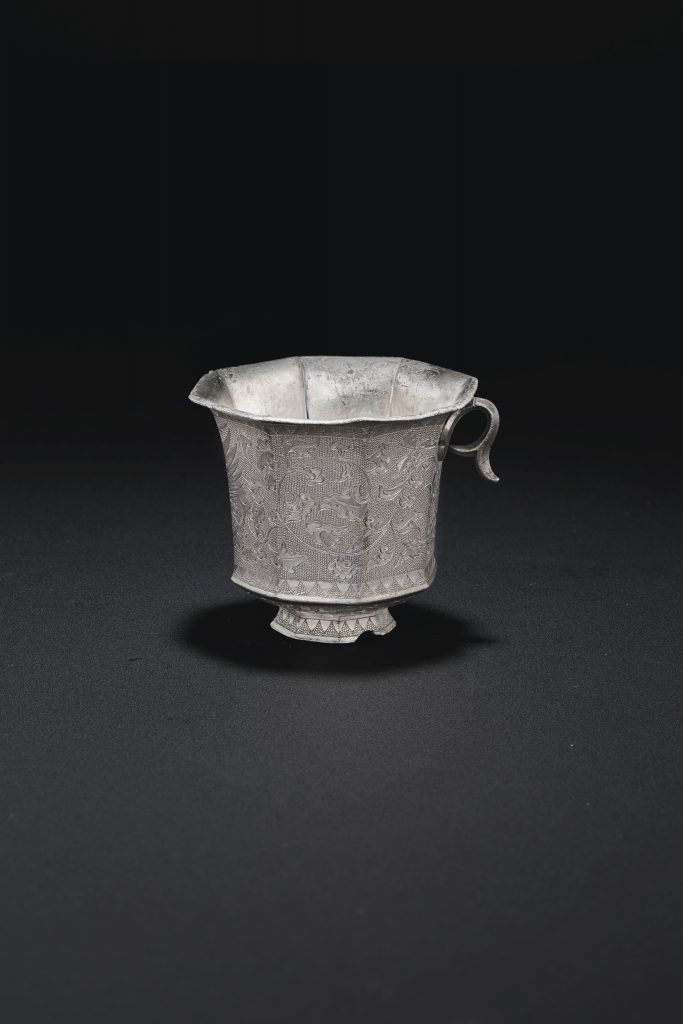
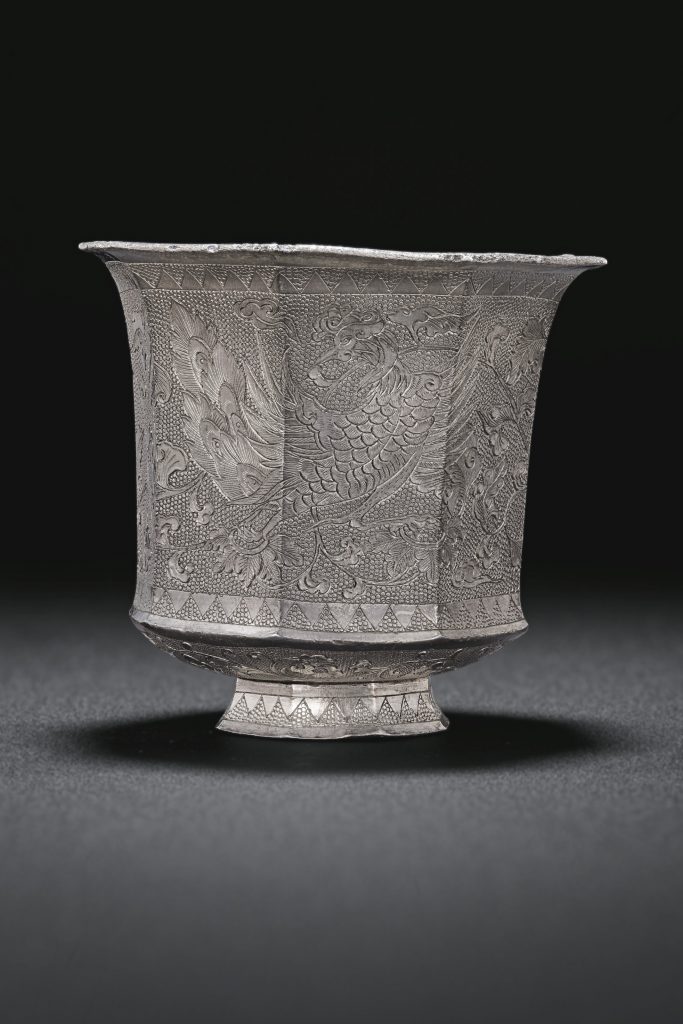
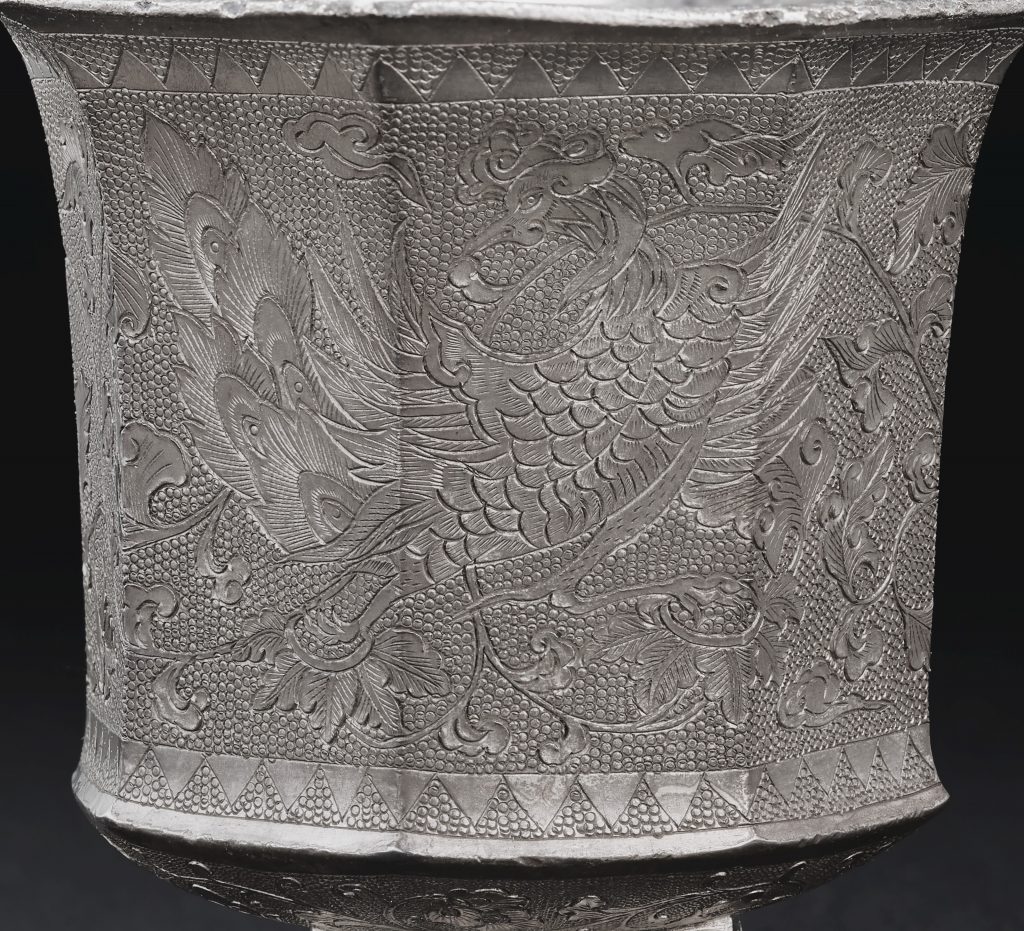
成交價USD 52,500
估價USD 8,000 – USD 12,000
細節
晚唐/遼 銀鳳穿花紋八稜盃
2 ½ in. (6.4 cm.) high; weight 112 g
來源
Mrs. Christian R. Holmes (1871-1941) Collection, New York.
Dr. Johan Carl Kempe (1884-1967) Collection, Sweden, before 1953, no. CK104.
Sotheby’s London, Masterpieces of Chinese Precious Metalwork. Early Gold and Silver, 14 May 2008, lot 45.
出版
Bo Gyllensvärd, Chinese Gold and Silver in the Carl Kempe Collection, Stockholm, 1953, cat. no. 104.
Bo Gyllensvärd, ‘T’ang Gold and Silver’, Bulletin of the Museum of Far Eastern Antiquities, No. 29, Stockholm, 1957, pl. 9c, figs. 24b, 63f, 95e.
Chinese Gold and Silver in the Carl Kempe Collection, The Museum of Art and Far Eastern Antiquities in Ulricehamn, Ulricehamn, 1999, pl. 109.
Qi Dongfang, Tangdai jin yin qi yan jiu [Research on Tang gold and silver], Beijing, 1999, p. 349, fig. 3-49.
展覽
Washington, D.C., Smithsonian Institution, Chinese Gold and Silver in the Carl Kempe Collection, 1954-55, cat. no. 104.
狀況報告
We have sought to record changes in the condition of this piece acquired after its initial manufacture.
– the foot has been reglued to the base
– two small chips to the foot rim
– nicks and minor losses to the mouth rim
– some surface corrosion to the mouth rim
– expected surface wear and abrasion
参考:佳士得
19 3月 2015 | 現場拍賣 11421
錦瑟華年 – 安思遠私人珍藏
第四部分:中國工藝精品 ─ 金屬器、雕塑及早期瓷器
拍品 733南宋/元 銀花卉紋菱花式盌一對
A PAIR OF SILVER BRACKET-LOBED FLORIFORM STEM BOWLS
CHINA, SOUTHERN SONG-YUAN DYNASTY (1127-1368)
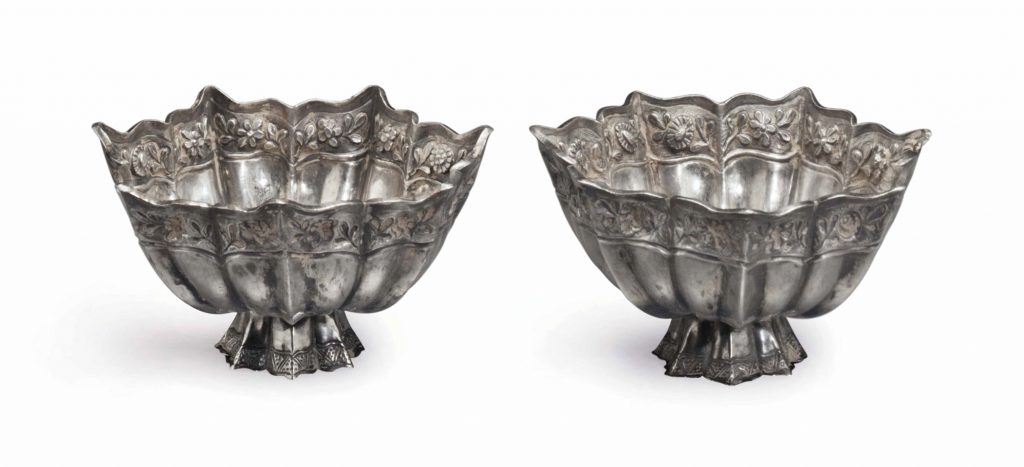
成交價 USD 47,500
估價 USD 7,000 – USD 9,000
This lot is offered without reserve.
Please note that the date for this lot should read: CHINA, SOUTHERN SONG-YUAN DYNASTY (1127-1368).
狀況報告
– both with minor nicks, scratches to the surface
– the feet have been separately cast and attached to the bowls, and there are a few minute holes where they are attached
– one with a short crack at the mouth rim
– both with earthy encrustation in the recessed areas and some patination of the silver
参考:佳士得
19 3月 2015| 現場拍賣 11421
錦瑟華年 – 安思遠私人珍藏
第四部分:中國工藝精品 ─ 金屬器、雕塑及早期瓷器
拍品 728唐 銀卷草紋花口盌
A SILVER LOBED OVAL BOWL
CHINA, TANG DYNASTY (AD 618-907)
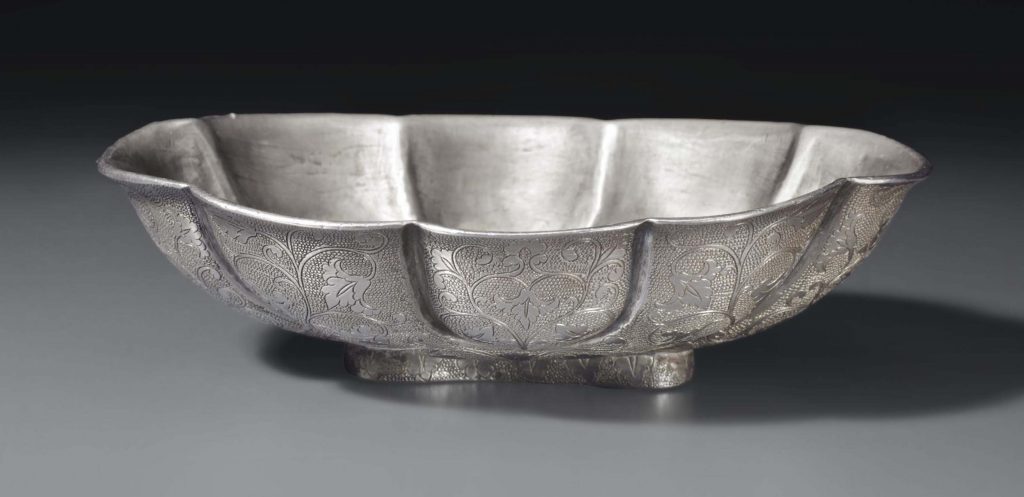
成交價 USD 81,250
估價 USD 15,000 – USD 20,000
來源
The Collection of Robert H. Ellsworth, New York, acquired in Hong Kong, 1993.
狀況報告
– minor nicks and scratches to the surface
– a few minute dents to the mouth and foot rims and to the raised moulding on the interior of the bowl
– the foot rim with areas of restoration, possibly a replacement
拍品專文
Three silver cups of this unusual lobed shape are illustrated by Ryoichi Hayashi in The Silk Road and the Shoso-in, New York/Tokyo, 1975, figs. 77, 78 and 96, only one of which, in the Hakutsuru Art Museum, is dated Tang dynasty, eighth century, which has parcel-gilt decoration on a ring-punched ground and has a lobed foot. The other two are described as Sassanian, fig. 77, dated sixth or seventh century, in the Idemitsu Art Gallery, which has a waisted rectangular foot, and fig. 96, dated sixth century, in the Tenri Museum, Nara, which has an oblong foot. Neither of these has a ring-punched ground, a Tang decorative technique that differentiates the background. Also illustrated, fig. 94, is a gilded-bronze cup dated eighth century in the Shoso-in, which is raised on a lobed foot, and is most likely Tang. The same shape can also be seen in a green glass cup in the Shoso-in, fig. 78. The author infers, p. 90, that this shape is most likely Sassanian in origin
参考:佳士得
19 3月 2015| 現場拍賣 11421
錦瑟華年 – 安思遠私人珍藏
第四部分:中國工藝精品 ─ 金屬器、雕塑及早期瓷器
拍品 726
A SMALL PARCEL-GILT SILVER STEM CUP
唐 銀局部鎏金鳥獸紋高足盃
CHINA, TANG DYNASTY (AD 618-907)
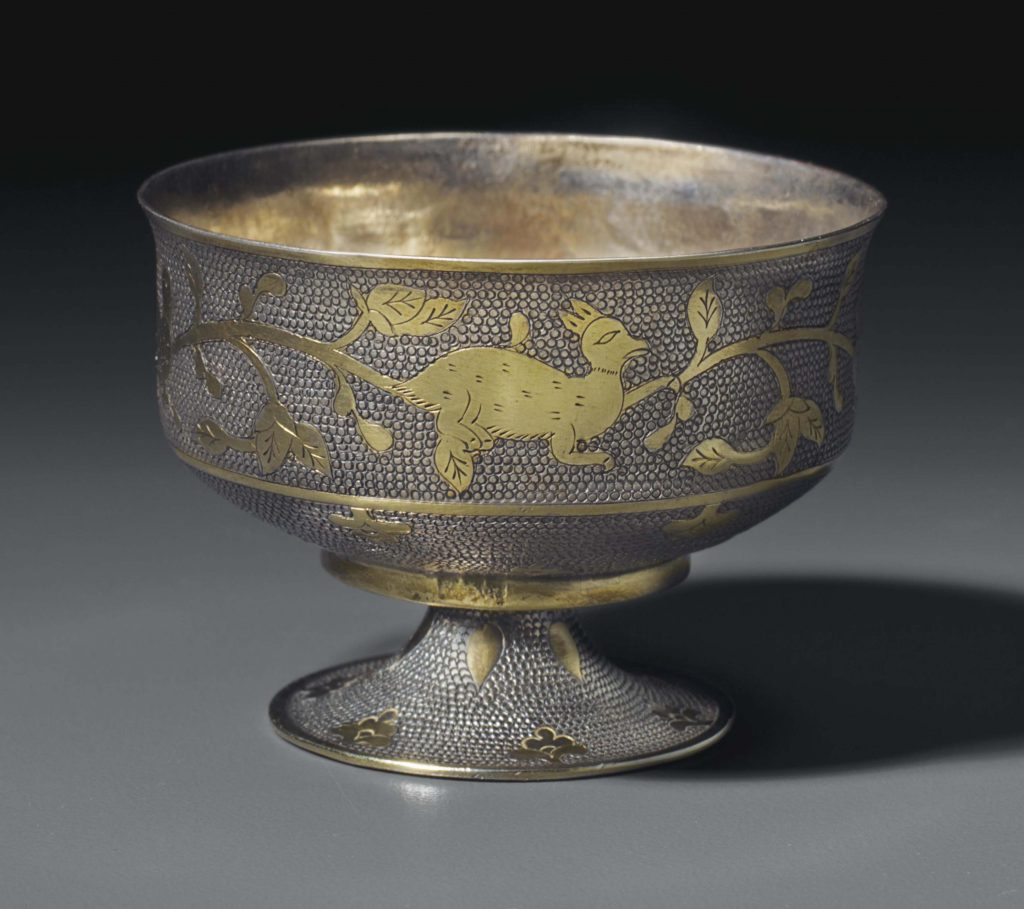
成交價 USD 12,500
估價 USD 4,000 – USD 6,000
來源
The Collection of Robert H. Ellsworth, New York, before 1990.
狀況報告
We have sought to record changes in the condition of this piece acquired after its initial manufacture.
– the raised edge on the underside of the cup with a few irregularities
– very minor wear to the gilding
– small areas of tarnish and patination on the interior and the base of the cup
参考:
A very fine small flower-shaped silver stem cup,
Tang dynasty, late 7th-early 8th century
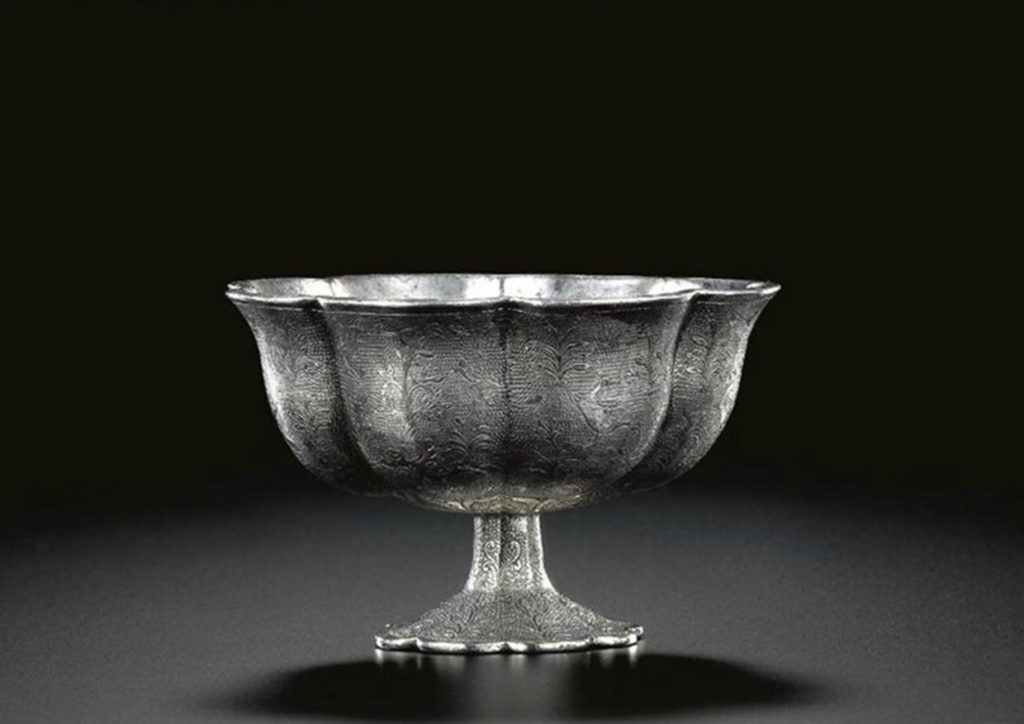
Lot 40. A very fine small flower-shaped silver stem cup, Tang dynasty, late 7th-early 8th century, 4.5cm., 1 3/4 in. Estimate 30,000 — 40,000 GBP. Lot sold 144,500 GBP. Photo: Sotheby’s.
the small shallow bowl divided into eight petal-shaped lobes and resting on a short stem with a wide fluted petal-shaped foot, the sides delicately chased and engraved with ducks and parrots, some in flight, others alternately facing each other or with heads turned back, set in a landscape amidst rockwork and trees, all reserved on a minute ring-punched ground, the stem embellished with a band of lotus petals. WEIGHT 331g.
Exhibited: Chinese Gold and Silver in the Carl Kempe Collection, Smithsonian Institution, Washington, D.C., 1954-55, cat. no. 110.
Chinese Gold, Silver and Porcelain. The Kempe Collection, Asia House Gallery, New York, 1971, cat. no. 54.
Literature:Bo Gyllensvärd, Chinese Gold and Silver in the Carl Kempe Collection, Stockholm, 1953, pl. 110.
Bo Gyllensvärd, ‘T’ang Gold and Silver’, Bulletin of the Museum of Far Eastern Antiquities, no.29, 1957, pp.1-230, fig. 62m.
Han Wei, Hai nei wai Tangdai jin yin qi cuibian [Tang gold and silver in Chinese and overseas collections], Xi’an, 1989, pl. 59.
Chinese Gold and Silver in the Carl Kempe Collection, The Museum of Art and Far Eastern Antiquities in Ulricehamn, Ulricehamn, 1999, pl. 113.
Note: Stemcups of this elegant flower-shaped form with lobed body and the stem in the form of flaring fluted petals are extremely rare, although a closely related gilded silver six lobed stemcup decorated with a hunting scene in the Hakutsuru Fine Art Museum, Kobe, is illustrated in Sekai bijutsu taizenshu: Toyo hen, vol. 4, Tokyo, 1997, pls. 168-169; another example in the British Museum, London, is published in Jessica Rawson, ‘The Ornament on Chinese Silver of the Tang Dynasty (AD 618-906), Occasional Paper, no.40, London, 1982, pl. 1.
Cup
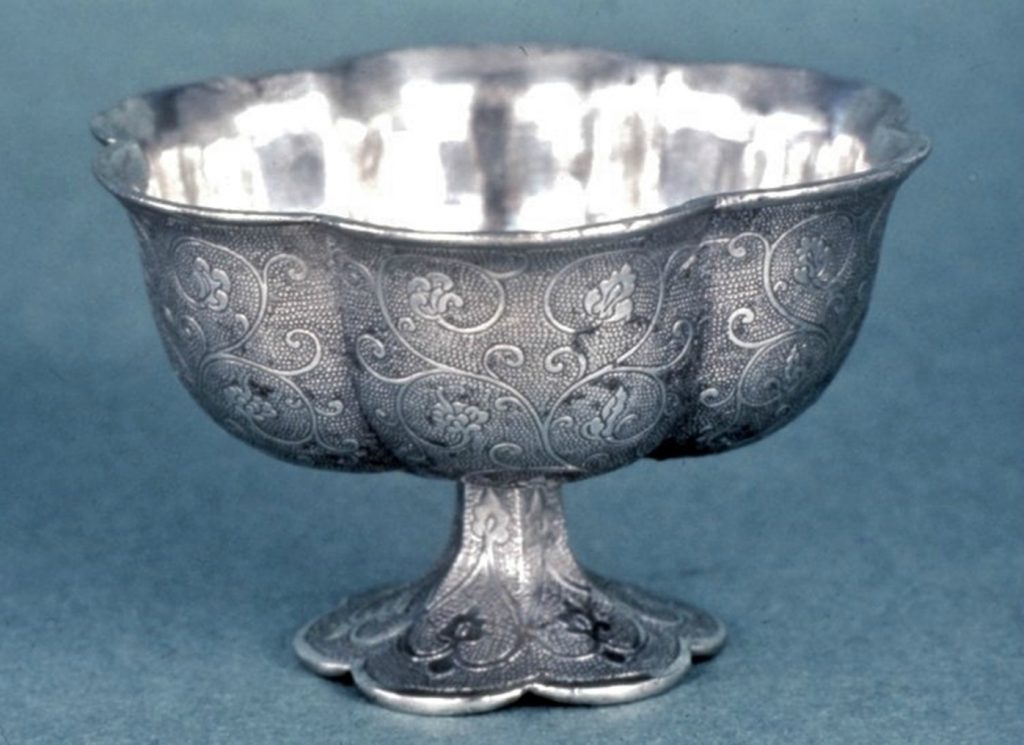
See also a stemcup with a similar eight-lobed foot but with a less distinctly lobed body, from the Nelson Gallery, Atkins Museum, Kansas City, included in the China Institute of America exhibition Early Chinese Gold and Silver, China House Gallery, New York, 1971, cat.no. 74; and another, from the Mayer collection and illustrated in Bo Gyllensvard, Tang Gold and Silver, Bulletin of the Museum of Far Eastern Antiquities, no. 29, Stockholm, 1957, pl. 8e, sold at Christie’s London, 24/25thJune 1974, lot 156. A further comparable example, from the collections of David-Weill and Arthur M. Sackler, was sold at Christie’s New York, 1st December 1994, lot 65.
It is rare to find Tang silver bowls of this simple yet elegant form decorated with an overall chased design as seen on the present vessel. The design pattern is expertly placed and superbly executed, a testament to the very fine workmanship of the Tang silversmith. Vessels of this exquisite quality and rich decorative motif were made for imperial use at the many banquets held by the Tang court. For further information on the use of silver and gold utensils used at banquets see Han Wei, ‘Gold and Silver Vessels of the Tang Period’, Orientations, July 1994, pp. 31-35.
Compare also a cup illustrated in Zhongguo jin yin boli falangqi quanji, vol. 2, Shijiazhuang, 2004, pl. 6, in the Shaanxi History Museum; and another included in the exhibition Chinesisches Gold und Silber. Die Sammlung Pierre Uldry, Museum Rietberg, Zurich, 1994, cat. no. 136.
Sotheby’s. London, Masterpieces of Chinese Precious Metalwork: Early Chinese Gold and Silver, 14 May 2008
参考:佳士得
9月12日 2019 | 現場拍賣 18338
金紫銀青 – 中國早期金銀器粹珍
NewYork
2019 | Live Auction 18338
拍品 549 唐 刻花鳥紋高足花口盃
Masterpieces of Early Chinese Gold and Silver
Lot 549 A VERY FINE PETAL-LOBED SILVER STEM CUP
TANG DYNASTY (AD 618-907)
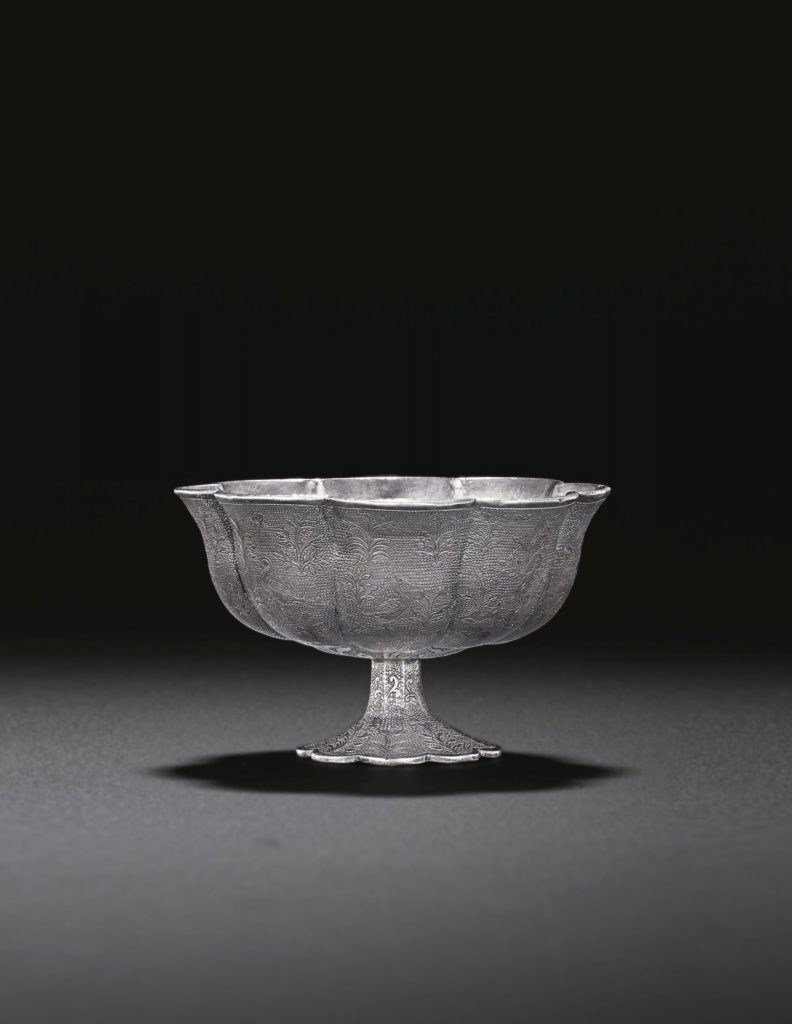
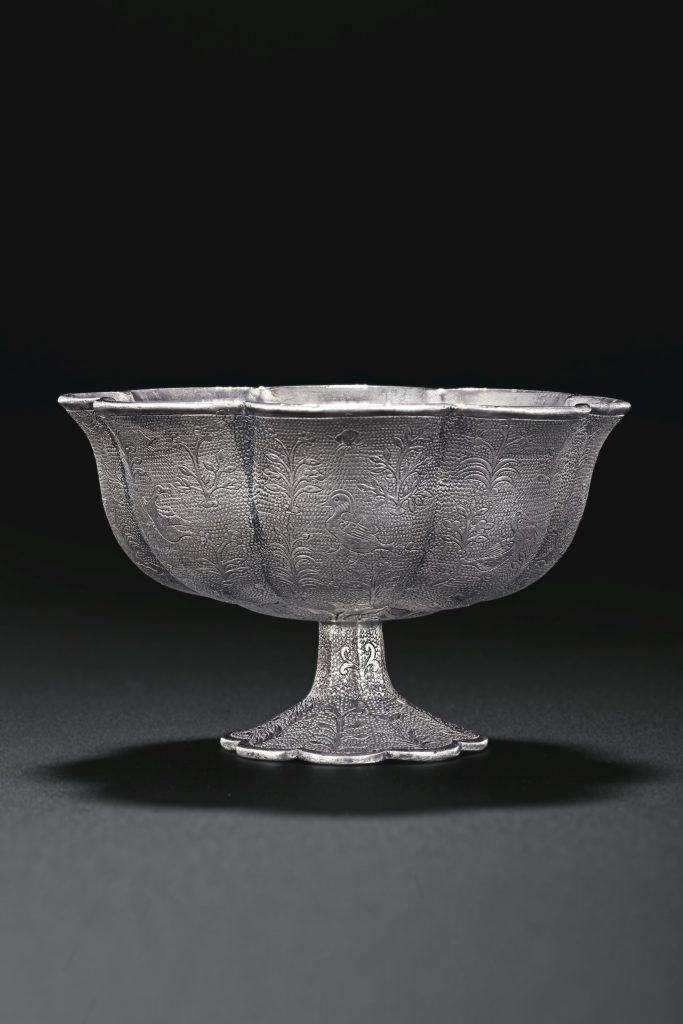
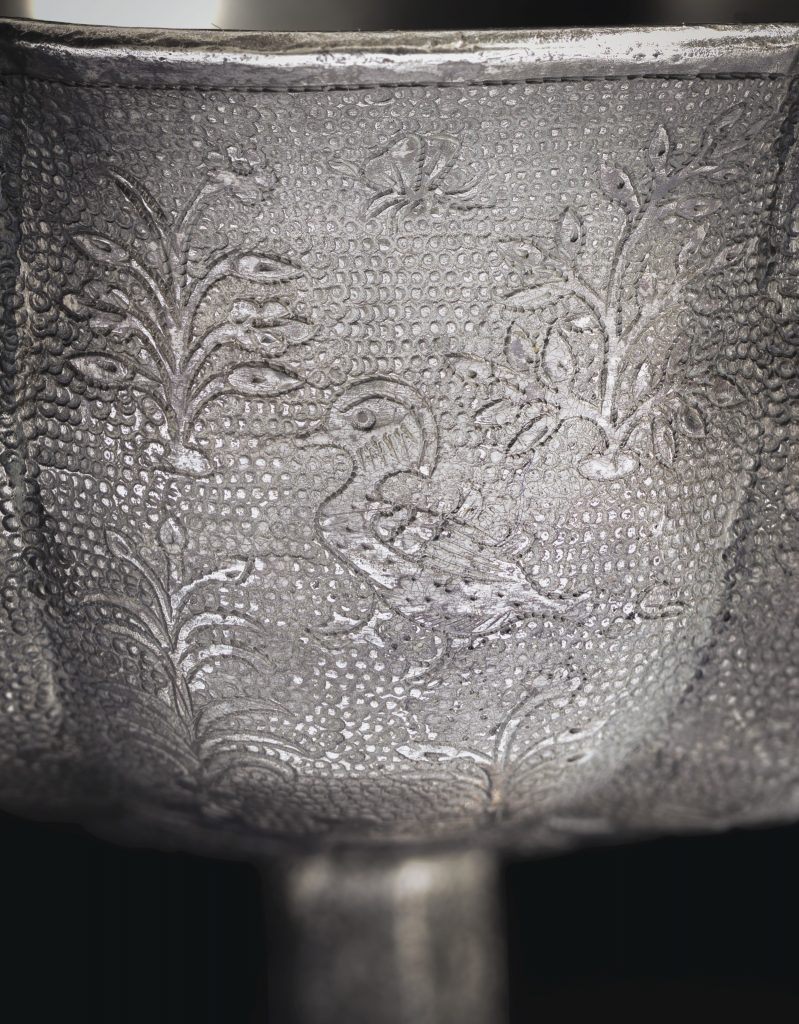
Price realised USD 187,500
Estimate USD 50,000 – USD 70,000
A VERY FINE PETAL-LOBED SILVER STEM CUP
TANG DYNASTY (AD 618-907)
The small bowl is divided into eight petal-shaped lobes, each delicately engraved with birds including ducks, geese and a parrot amidst rocks and trees in a landscape, the birds shown either in flight, or alternately looking towards or away from each other, all against a very fine ring-punched ground above engraved lotus petals rising from the stem foot with spreading, petal-lobed base similarly decorated with bands of foliate scrolls.
2 ¾ in. (6.9 cm.) diam.; weight 85 g
Provenance
Dr. Johan Carl Kempe (1884-1967) Collection, Sweden, before 1953, no. CK110.
Sotheby’s London, Masterpieces of Chinese Precious Metalwork. Early Gold and Silver, 14 May 2008, lot 40.
Literature
Bo Gyllensvärd, Chinese Gold and Silver in the Carl Kempe Collection, Stockholm, 1953, cat. no. 110a.
Bo Gyllensvärd, ‘T’ang Gold and Silver’, Bulletin of the Museum of Far Eastern Antiquities, No. 29, Stockholm, 1957, pl. 8b, fig. 62m.
Han Wei, Hai nei wai Tangdai jin yin qi cuibian [Tang gold and silver in Chinese and overseas collections], Xi’an, 1989, pl. 59.
Chinese Gold and Silver in the Carl Kempe Collection, The Museum of Art and Far Eastern Antiquities in Ulricehamn, Ulricehamn, 1999, pl. 113.
Qi Dongfang, Tangdai jin yin qi yan jiu [Research on Tang gold and silver], Beijing, 1999, pl. 8.
Exhibited
Washington, D.C., Smithsonian Institution, Chinese Gold and Silver in the Carl Kempe Collection, 1954-55, cat. no. 110.
New York, Asia House Gallery, Chinese Gold, Silver and Porcelain. The Kempe Collection, 1971, cat. no. 54, an exhibition touring the United States and shown also at nine other museums.
Brought to you by
Chinese Ceramics & Works of Art
Check the condition report or get in touch for additional information about this
Condition Report
We have sought to record changes in the condition of this piece acquired after its initial manufacture.
– appears to be in overall very good condition
– expected minor nicks and small dents to the edges and minor abrasion to the surface
– patina varies with a few darker bluish-grey areas
– remnants of a CK number in black ink on the underside of the foot
Lot Essay
Silver stem cups of this elegant, lobed shape, where the lobes continue up to a slightly everted edge, are very rare. A very similar stem cup from the collection of Martin Mansson was sold at Christie’s London, 10 May 2011, lot 178. The Mansson cup was referenced by Gyllensvärd in his various catalogues of the Kempe Collection as a comparable of the present cup. Another cup of this shape, decorated with hunting motifs, dated to the 8th century, is in the Hakutsuru Art Museum and illustrated by Ryoichi Hayashi, The Silk Road and the Shoso-in, New York/Tokyo, 1975, p. 86, pl. 88.
参考:Christie’s
現場拍賣 15449
中國瓷器及工藝精品 22 Mar 2018
2018 | Live Auction 15449
Fine Chinese Ceramics and Works of Art
Lot 916 唐 銅鎏金纏枝花卉紋高足盃
A SMALL FINELY-ENGRAVED GILT-BRONZE STEM CUP
TANG DYNASTY (AD 618-907)
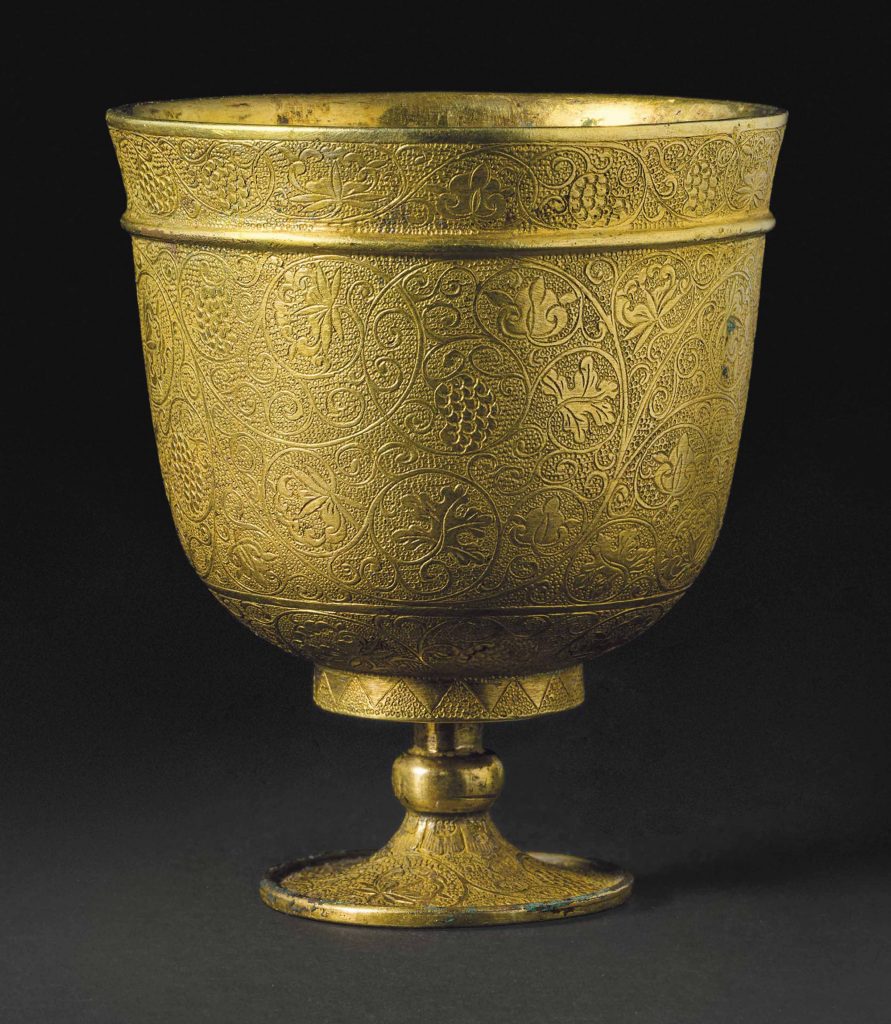
A SMALL FINELY-ENGRAVED GILT-BRONZE STEM CUP
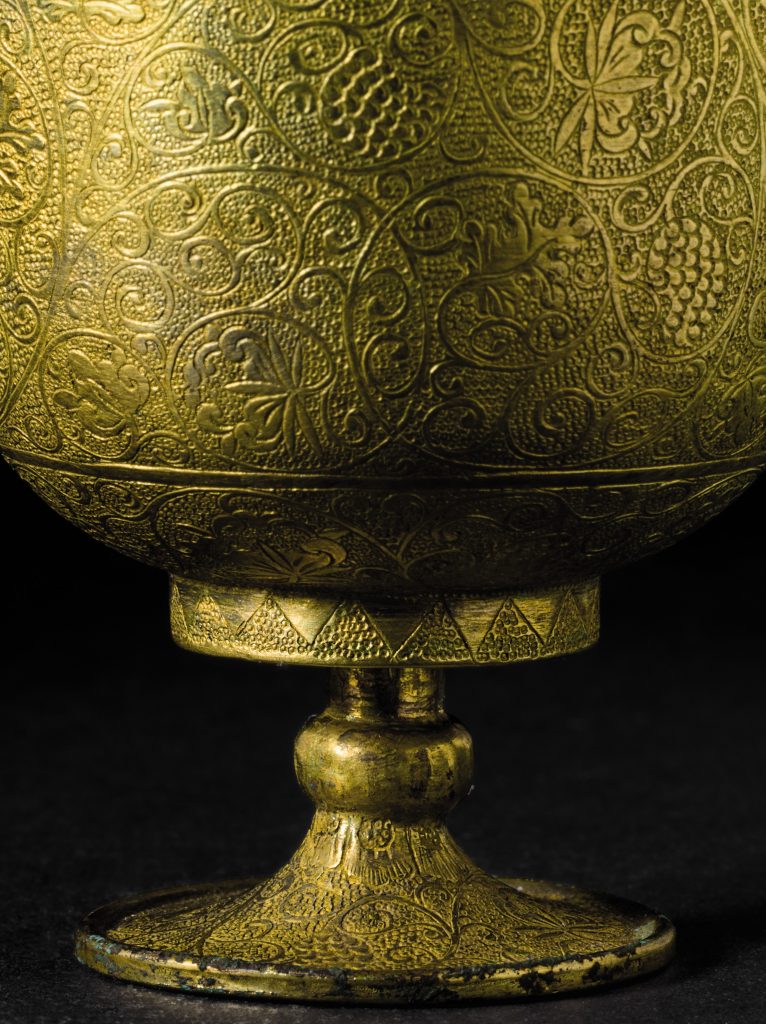
A SMALL FINELY-ENGRAVED GILT-BRONZE STEM CUP
Price realised USD 56,250
Estimate USD 30,000 – USD 50,000
Details
A SMALL FINELY-ENGRAVED GILT-BRONZE STEM CUP
TANG DYNASTY (AD 618-907)
The deep sides of the cup are engraved with meticulous details with a wide band of leafy flower scroll reserved on a ring-punched ground between narrow bands of similar decoration above and below, and repeated on the spreading foot, and is covered overall in thick, well-preserved gilding.
2 ½ in. (6.3 cm.) high, Japanese wood box
Provenance
Acquired in Japan, 1997.
狀況報告
We have sought to record changes in the condition of this piece acquired after its initial manufacture.
– appears to be overall good condition
– some expected minor dents and nicks to the metal
– some areas of malachite and earth encrustation, mostly to the interior and foot
Lot Essay拍品專文
This superbly engraved stem cup exemplifies the refinement of Tang dynasty metalwork. A cup of this form decorated with scrolling vines and grape leaves was unearthed from the reliquary chamber of the pagoda at the Qingshan Temple in Lindongxian, Shaanxi province. The construction of the temple was begun in 736, and in 740 the reliquary was placed in the subterranean chamber of the pagoda along with other objects of gold, silver, bronze and ceramic.
Other cups of this shape with varying foliate scroll decoration are in private and public collections, including one illustrated by B. Gyllensvard, Chinese Gold & Silver in the Carl Kempe Collection, Stockholm, 1953, no. 102; one illustrated in Ancient Chinese Arts in the Idemitsu Collection, Tokyo, 1989, no. 320; one in the collection of Senator Hugh Scott, illustrated in the Golden Age of Chinese Art, 1970, no. 18; one in the collection of Ostasiatische Kunstabteilung, Berlin, included in the Exhibition of Chinese Art, Berlin, 12 January – 2 April 1929, no. 438; and another from the Erwin Harris Collection, sold at Christie’s New York, 16 March 2017, lot 876 (part).
参考:佳士得
Christie’s
2019 | 現場拍賣 18338
金紫銀青 – 中國早期金銀器粹珍
拍品 600 唐 銀刻卷草花果紋高足盃
TANG DYNASTY (AD 618-907)
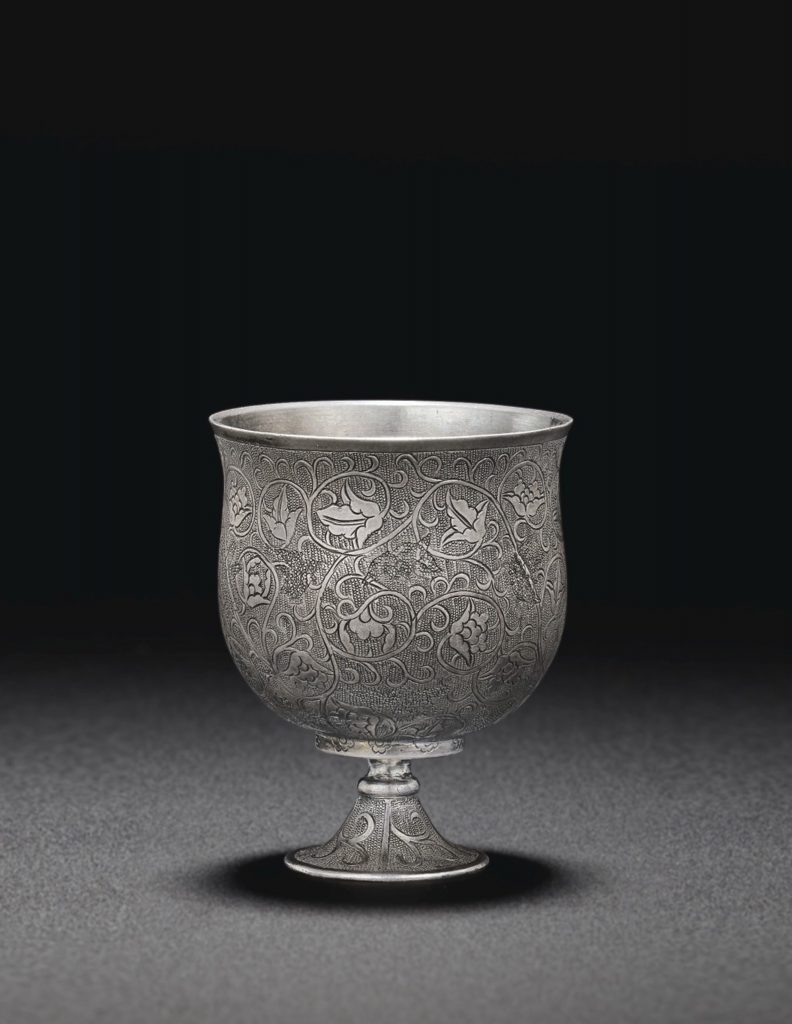
成交價 USD 52,500
估價USD 10,000 – USD 15,000
細節
唐 銀刻卷草花果紋高足盃
2 3/8 in. (6 cm.) high; weight 47.7 g
來源
Dr. Johan Carl Kempe (1884-1967) Collection, Sweden, before 1953, CK103.
Sotheby’s London, Masterpieces of Chinese Precious Metalwork. Early Gold and Silver, 14 May 2008, lot 66.
出版
Bo Gyllensvärd, Chinese Gold and Silver in the Carl Kempe Collection, Stockholm, 1953, cat. no. 103.
Bo Gyllensvärd, ‘T’ang Gold and Silver’, Bulletin of the Museum of Far Eastern Antiquities, No. 29, Stockholm, 1957, fig. 25e.
Han Wei, Hai nei wai Tangdai jin yin qi cui bian, [Tang Gold and Silver in Chinese and overseas collections], Xi’an, 1989, pl. 44.
Chinese Gold and Silver in the Carl Kempe Collection, The Museum of Art and Far Eastern Antiquities in Ulricehamn, Ulricehamn, 1999, pl. 105.
展覽
Washington, D.C., Smithsonian Institution, Chinese Gold and Silver in the Carl Kempe Collection, 1954-55, cat no. 103.
拍品專文
The goblet shape of this stem cup appears to be very rare. Another cup of this shape with similar decoration in the Yamato Bunkakan, Nara, Japan, is illustrated by Qi Dongfang, Tangdai jin yin qi yan jiu (Research on Tang gold and silver), Beijing, 1999, pl. 2, and again in a line drawing, p. 41, fig. 1-54. The flowers and leaves appear similar to those on the present cup, and one can see in pl. 2 that there are birds in flight amidst the scrolling vine, however they are chased or engraved and not ring-punched as they are on the present cup.
狀況報告
We have sought to record changes in the condition of this piece acquired after its initial manufacture.
– restored crack extending from the mouth rim into the side of the cup
– a few areas of surface abrasion and expected surface wear
– expected tarnishing to silver
唐 银质錾刻葡萄花卉纹高足杯(正面) 美国克利夫兰博物馆藏
唐 银质錾刻葡萄花卉纹高足杯 中国唐朝 (618-907) 银色,镀金内饰,切割和追逐装饰 整体:9厘米(3 9/16英寸) 爱德华·惠特莫尔基金1951.396
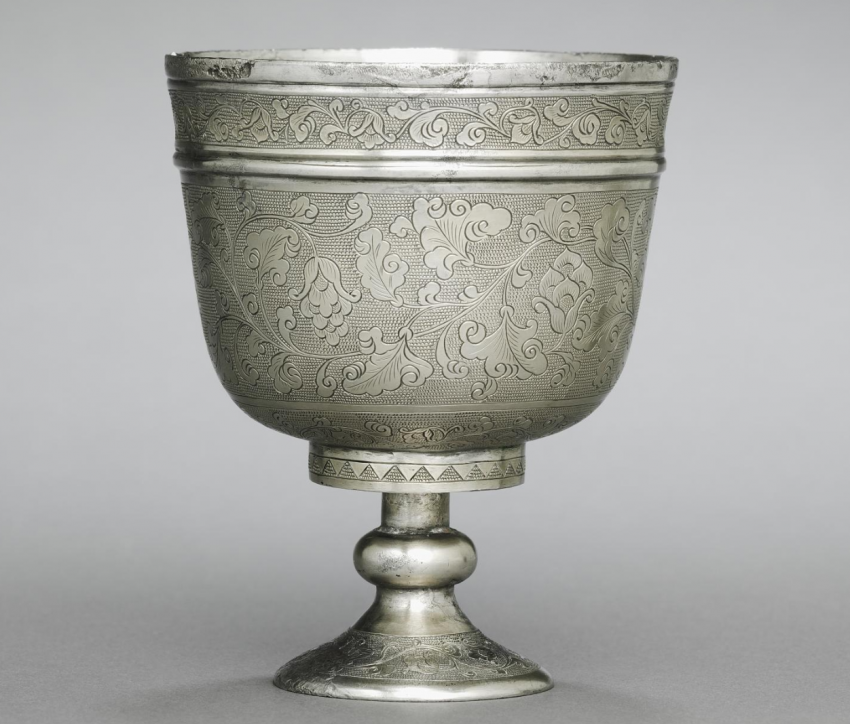
唐 錾刻珍珠地花卉纹高脚碗(底部) 美国弗利尔美术馆藏
唐 錾刻珍珠地花卉纹高脚碗 登记号 F1929.16历史时期 唐中叶,八世纪.唐(618-907)外型尺寸 高x直径:4.3 x 6.6厘米(1 11/16 x 2 5/8英寸)出处 1929年 Yamanaka and Company,波士顿,1929年[1] 从1929年的 弗里尔艺术画廊(Freer Gallery)于1929年从波士顿的Yamanaka and Company购买[2]
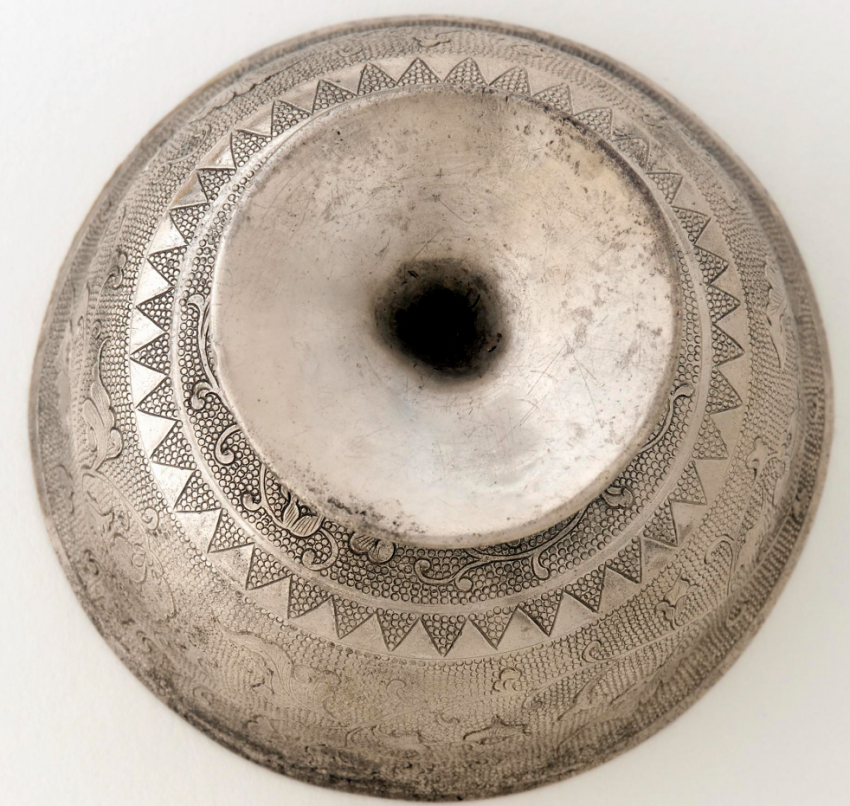
唐 银质錾刻葡萄花卉纹高足杯(纹饰1) 美国克利夫兰博物馆藏
唐 银质錾刻葡萄花卉纹高足杯 中国唐朝 (618-907) 银色,镀金内饰,切割和追逐装饰 整体:9厘米(3 9/16英寸) 爱德华·惠特莫尔基金1951.396
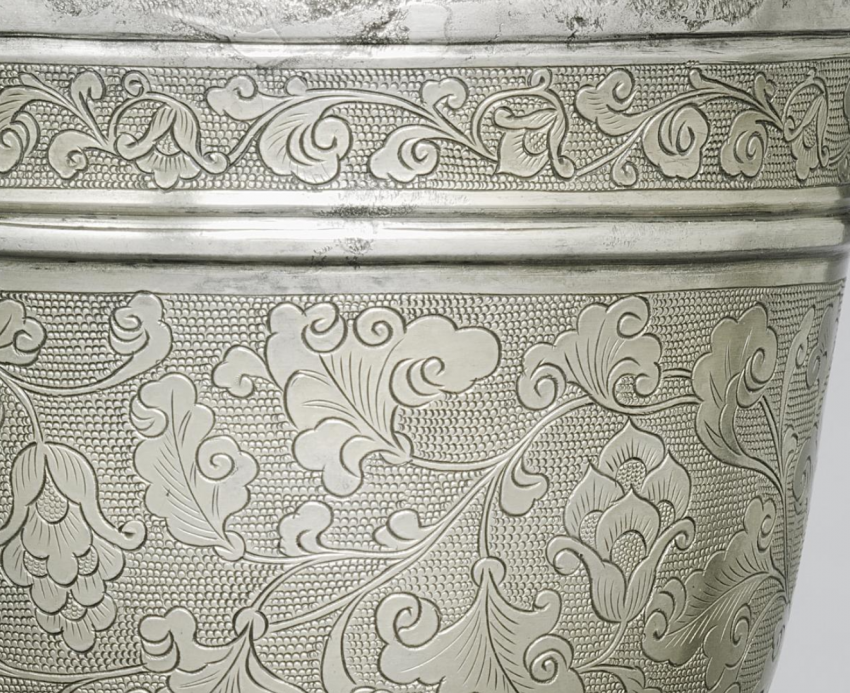
参考:佳士得
11 9月 2019 | 現場拍賣 18338
金紫銀青 – 中國早期金銀器粹珍
LOT 545 唐 银錾刻卷草葡萄纹高足杯
A small finely engraved silver stem cup,
Tang dynasty (618-907);
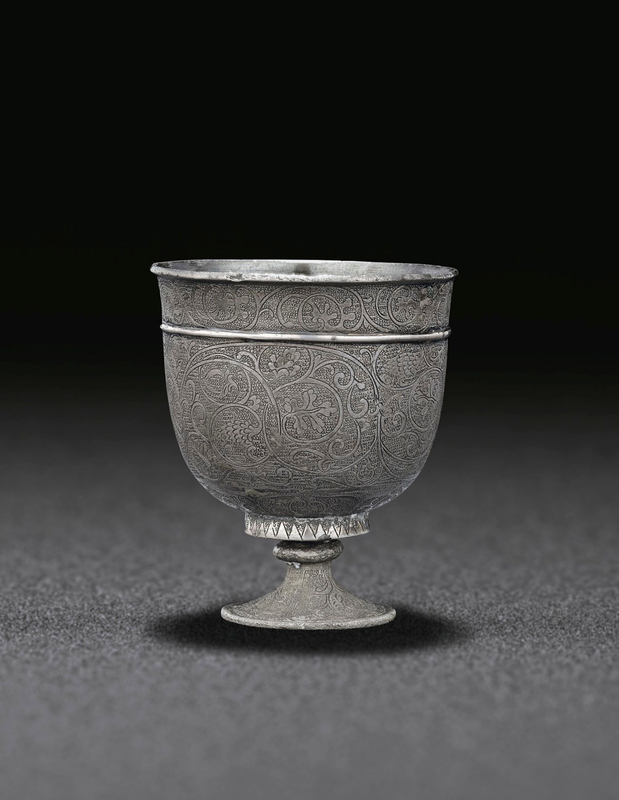
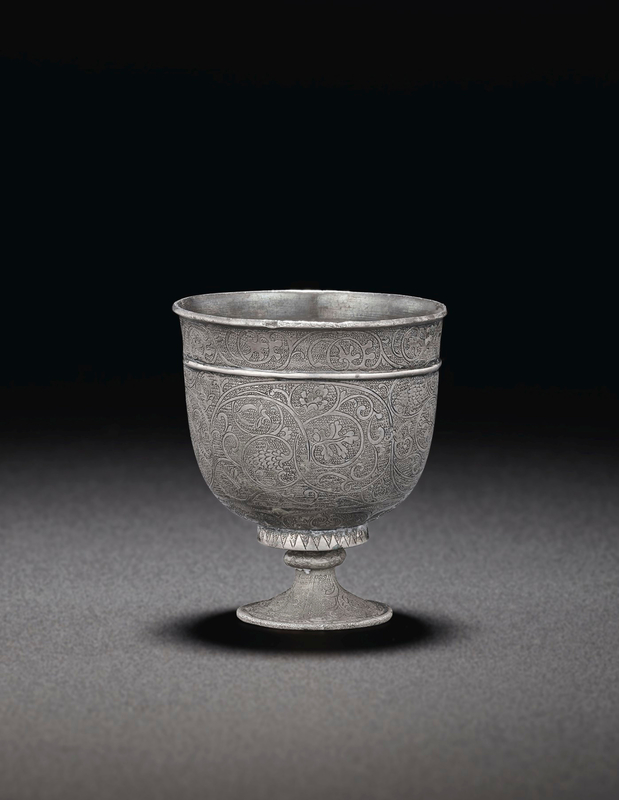
Estimate USD 40,000 – USD 60,000
估价 USD 40,000 – USD 60,000
高:5.1厘米;重量:36.4克
2 in. (5.1 cm.) high; weight 36.4 g.
The bell-shaped cup is raised on a knopped stem foot with spreading base. The deep sides are finely engraved with elaborate scrolling grapevine on a very fine ring-punched ground below a similar band at the mouth rim, all above a petal band and a saw-tooth band encircling the circular ring at the top of the stem.
Provenance: Dr. Johan Carl Kempe (1884-1967) Collection, Sweden, before 1953, no. CK102.
Sotheby’s London, Masterpieces of Chinese Precious Metalwork. Early Gold and Silver, 14 May 2008, lot 47.
Literature:
Bo Gyllensvärd, Chinese Gold and Silver in the Carl Kempe Collection, Stockholm, 1953, cat. no. 102.
Bo Gyllensvärd, ‘T’ang Gold and Silver’, Bulletin of the Museum of Far Eastern Antiquities, Stockholm, No. 29, 1957, figs. 55a, 75c, 86b, 87f.
Han Wei, Hai nei wai Tangdai jin yin qi cui bian, [Tang Gold and Silver in Chinese and overseas collections], Xi’an, 1989, pl. 44.
Chinese Gold and Silver in the Carl Kempe Collection, The Museum of Art and Far Eastern Antiquities in Ulricehamn, Ulricehamn, 1999, pl. 104.
Exhibited:
Washington, D.C., Smithsonian Institution, Chinese Gold and Silver in the Carl Kempe Collection, 1954-55, cat. no. 102.
Note: Cups of this goblet shape were popular during the Tang dynasty, and are found with varying decorations, often a scrolling foliate pattern, and more rarely a scrolling grapevine such as that seen on the present cup. A stem cup with this decoration is illustrated in Sui to no bijutsu, Osaka Municipal Art Museum, 1976, p. 32, no. 2-23. It can also be seen on two bottle-shaped silver vases of Tang date, illustrated by Clarence W. Kelley, Chinese Gold & Silver in American Collections, The Dayton Art Institute, Dayton, Ohio, 1984, no. 49, dated early 8th century, and no. 50, dated late 8th-9th century. On both of these, birds and animals are interspersed amidst the grape vine. A cup of this form decorated with scrolling grape vines was unearthed from the reliquary chamber of the pagoda at the Qingshan Temple in Lindongxian, Shaanxi province. The construction of the temple was begun in AD 736, and in AD 740 the reliquary was placed in the subterranean chamber of the pagoda along with other objects of gold, silver, bronze and ceramic.
参考:北京景星麟凤国际拍卖有限公司
2019年4月19日-21日
北京昆仑饭店二层昆仑堂
大唐西市2019春季艺术品拍卖会
海泊遗珍——清代外销银器专场
Lot.1810 清代 珐琅大银碗
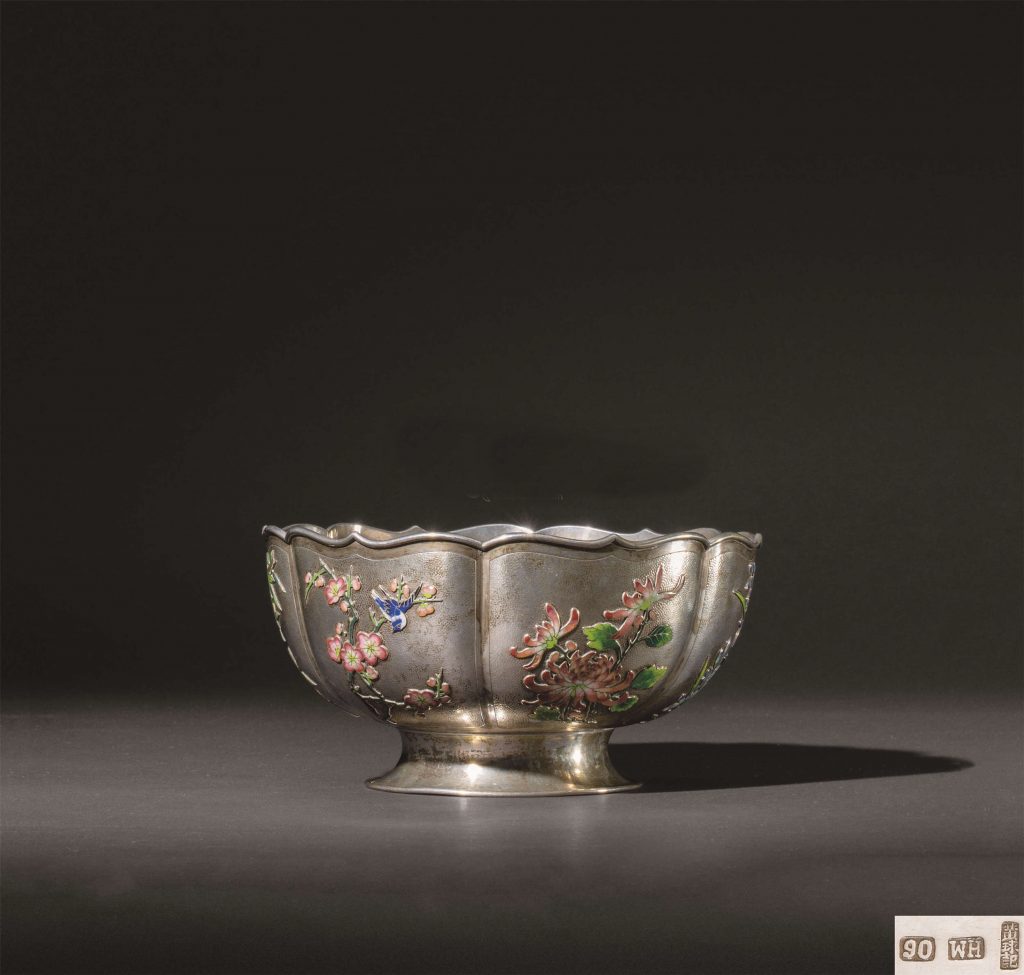
Starting price:CNY280,000
Estimate :暂无估价
Size:高11cm;口径21cm;重821.8g
Description
银戳:
款识“黄球记”为广州著名银楼黄球记公司
说明:
此碗以中国著名的珐琅工艺装饰。葵花形口,碗腹部六瓣花瓣分别饰梅花喜鹊、菊花、兰花、牡丹、水仙、竹叶纹饰,填入的珐琅彩料鲜艳夺目。圈足外撇。梅象征高洁,兰花象征贤达,竹象征谦谦君子,菊象征自由。“喜上梅梢”寓意吉祥美好。此碗做工细致,保存完好,十分难得。“黄球记”是清末、民国时期广州著名的外销银器制作商,其产品珐琅大银碗在2009年以5万美元的价格创造了当年中国外销银器的拍卖纪录,由此人们也逐渐认识到中国外销银器的价值。“黄球记”制作的银器材质精良、工艺精美,在艺术品拍卖会上,只要出现“黄球记”制作的外销银器,立刻会成为藏家争相竞标的焦点。珐琅器是以珐琅为材料装饰而成的器物。珐琅又称“佛郎”“法蓝”,依据加工工艺的不同,可分为掐丝珐琅器、錾胎珐琅器、画珐琅器和透明珐琅器等品种。珐琅工艺起源于阿拉伯国家,于元代传入我国,到14世纪末珐琅技艺日趋成熟,15世纪中期明代景泰年间的制品尤为著名,故有景泰蓝之称。珐琅采用石英、长石、硝石和碳酸钠等加上铅和锡的氧化物涂在铜质或银质器物上烧制形成,形成不同颜色的油脂表面,既可防锈,又可装饰。珐琅银器属于银胎珐琅器,色彩绚丽,具有宝石般的光泽和质感,可历经千年而光泽不变,艺术水平极高,被誉为“世界上最奢侈的艺术品”。存世极少,弥足珍贵。

![[临渊阁]天地一家春](https://www.antiquekeeper.ca/wp-content/uploads/2023/04/BW-Erping-1a-17-6-1.jpg)
